
A Peru travel guide to show you how to travel to Peru adventurously and safely, with tips on transport, treks and sightseeing highlights.
Those who travel to Peru are usually those also stepping foot on the South American continent for the first time since the country serves as an easy gateway to wider adventure.
Peru is a diverse spectrum of landscapes beyond its famed jungle and highlands and the stretch of desert on the west coast. It dazzles with its Colonial architecture, marvels with mystery as people seek out its ancient Inca sites and the pilgrimage to Machu Picchu, and tempts people into its untouched nature from deep canyon to high mountain peak as travellers seek out adrenalin fuel with a view.
Despite being more on the trodden path (with a chance to get off it a little), and because it is one of the cheapest of the 12 countries that make up the continent, travelling to Peru can still seem overwhelming for the first time visitor.
My visit to Peru also marked my first time in South America. I searched high and low to gather all the information I needed to capture the scenic and historical highlights, make the most of my budget and time, and stay safe when South America still has a less than desirable reputation in parts.
Here, I’ve pulled everything you need to know as a comprehensive one-stop Peru travel guide, from what to see and how much you spend, to safety and the most responsible, ethical travel choices you can make here.
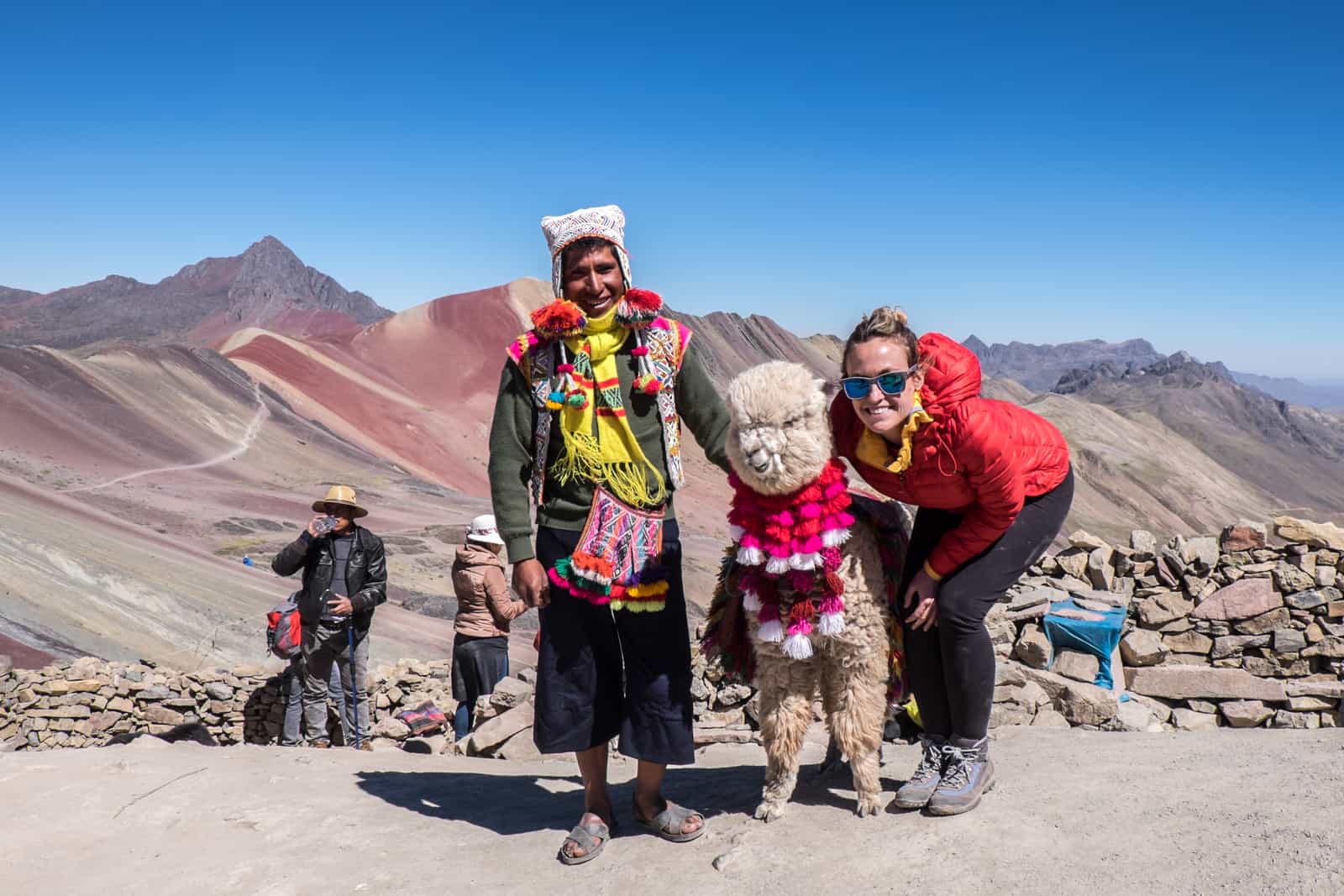
This Is How to Travel to Peru – All You Need to Know Guide
When is the Best Time to Visit Peru?
Wet vs. Dry Seasons in Peru
The easiest way to determine when is the best time to travel to Peru is by breaking it down into the country’s wet and dry seasons:
- May to October / November is the dry season in Peru
- December to March / April is the rainy season in Peru
- April and November are typically considered the shoulder seasons in Peru, where anything goes as the seasons pass over
- February is the hottest month in Peru, and August is the coldest.
Wet vs. Dry Landscape in Peru
Peru is an adventure holiday capital. Therefore, considering the country’s diverse topography from desert to jungle, the weather outcome also depends on where you plan to visit in Peru and what activities you will be doing.
For example, it’s not a good idea to visit the jungle highland and mountain areas to the north and those around Cusco and the Sacred Valley during the rainy season, where there is a high possibility of trails and pathways even to Machu Picchu being closed. Lima, conversely, would be more accessible since it is situated on the desert coastline.
Do you need a Visa for Peru?
As the Tourism website states, Peru is “a country of open doors,” and for American and Western European countries, no visa is required for travel.
The citizens of the following countries do not require a Peru visa:
- North America: the United States, Canada, and Mexico.
- South America: All South American countries.
- Central America: All Central American countries except Costa Rica, Cuba, Dominican Republic, El Salvador, Guatemala, Haiti, Honduras, and Nicaragua.
- Europe: All countries within the European Union (EU) and Switzerland.
- Africa: South Africa.
- Middle East: Israel.
- Asia: Brunei, Indonesia, Japan, Laos, Malaysia, Philippines, Singapore, and Thailand.
- Oceania: Australia and New Zealand.
However, check your country’s consulate for up-to-date information and any changes before you embark on your Peru holidays.
You can check if you need a visa and how many days you get upon entry here.
Tourist entry to Peru is a single entry stamp at the airport or land border that grants you a maximum stay of 183 days. You need a passport valid for at least six months and with at least two free pages. The entry stamp cannot be extended once you are inside the country, and any overstay time can be met with a fine.
Travel to Peru from Neighbouring Countries Overland
A Peru trip is surrounded by travel temptation, with borders to Ecuador and Colombia in the north, Bolivia and Brazil in the east, and Chile to the South. That makes Peru a perfect starting point for onward travel or the ideal country to travel to, paired with a neighbour.
Entering Peru from neighbouring countries overland requires you to do some immigration legwork afterwards. Immigration authorities may not allow you to leave Peru without proof of a valid exit stamp from the last country you visited, and it is required by law to apply for an entry stamp once you are in Peru. That is if you didn’t get an entry stamp at the land border. You will need to show authorities various documentation of your travel journey.
Ecuador to Peru
Via Huaquillas (the most popular), Macará or La Balsa at Zumba. If you enter Peru overland from Ecuador, you will need to get your passport stamped with a Peruvian entry stamp at the local immigration office where you are staying.
Bolivia to Peru
If you enter Peru from Bolivia via Copacabana, make sure your passport is stamped with a Peruvian entry stamp at the immigration office in Desaguadero or Copacabana (near Puno, which is a known traveller hub).
What is the Best Way to Travel Around Peru?
A large country with a lot of ground to cover, it’s important for this Peru travel guide to cover the best, safest and most cost-effective way to get around. Through means I’ve tried and tested.
Use the Peru Hop Bus – The Best Bus Travel in Peru
Furiously researching how I would travel from Lima to Cusco and see everything from the sand dunes, colonial cities and the manmade habitable lake islands in between, I mostly came across stories of dodgy local bus rides and rip-off taxi drivers.
Travelling within Peru is no longer difficult. In this research, I came across a great and relatively new bus service in Peru called Peru Hop, which gave me a pass to try out during my two-week journey from Lima to Cusco.
Peru Hop offers a multi-stop Flexi ticket in either direction between Lima and Cusco (and one that also takes you to La Paz, Bolivia), stopping at Paracas, Huacachina, Nazca, Arequipa and Puno in between. More than just a transport service, it acts as a flexible experience where you can tour Peru independently, adapting to your interests and itinerary. There are even extra, exclusive stops and Peru tours along the way.
It means having one ticket, one easy-to-use online booking system, maximum flexibility, and not dealing with rogue travel agents or the hassle of local bus stations. You can see the major cities and hotspots easily and safely (everyone who boards the bus has to have a valid seat booking, from which their passport details are logged), be picked up and dropped off at your hostel, and have the help of an onboard local guide who speaks English and Spanish.
Tickets start from $159 (valid for one year); you can read my full Peru Hop review here.
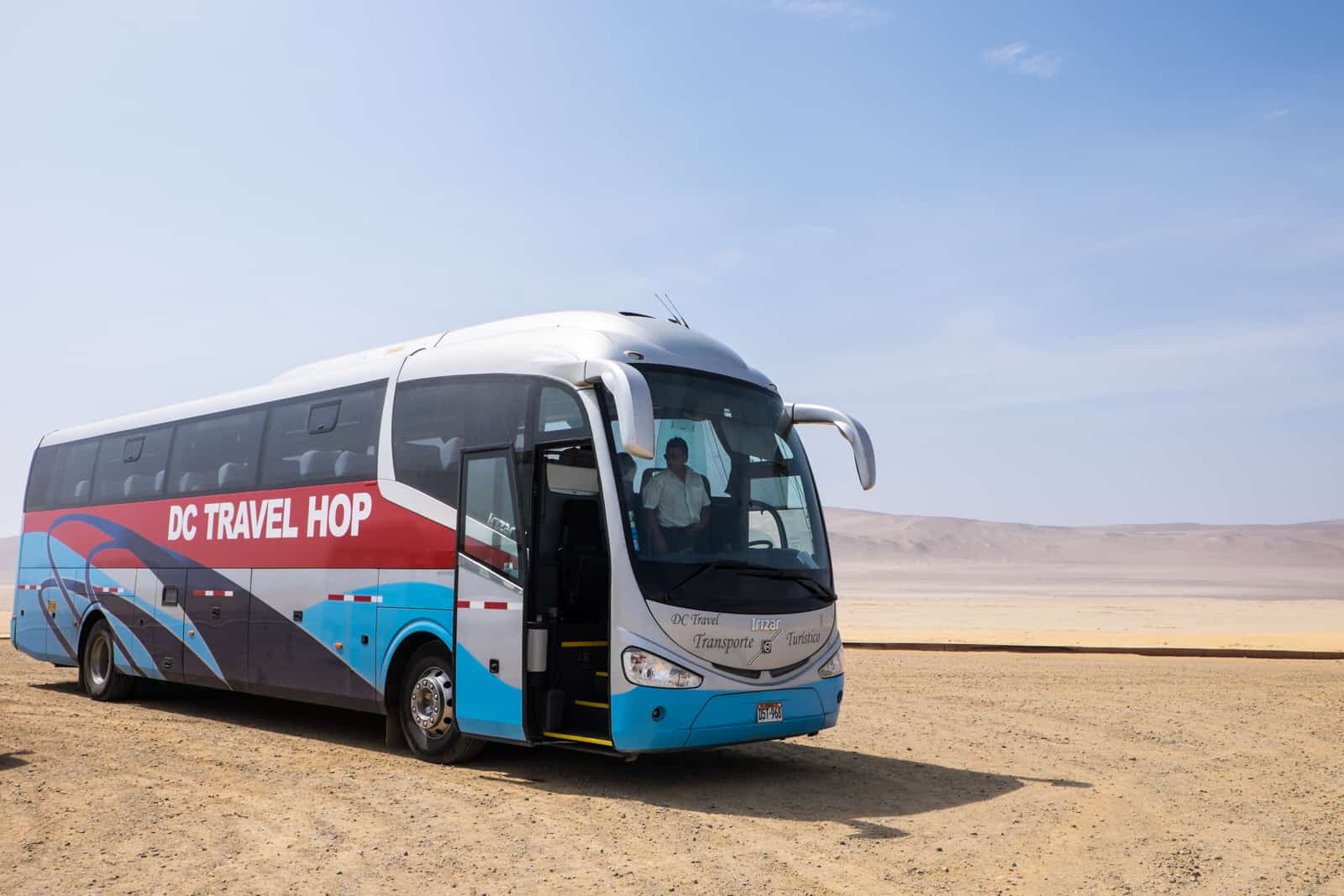
Buses are the easiest means of getting around Peru, with the Peru Hop service being great for accessible travel on the southern loop through major sites.
Flights to Peru and Travelling to and From Lima Airport
The best-priced flights to Peru usually get you to Lima, which becomes the main starting hub for the majority of travellers. The company behind Peru Hop also operates the Airport Express Lima bus that has multiple stops in the city centre.
You can book online or show up and hope for space. This is a cheaper option than the taxi pick-ups organised by many hostels, although I much preferred the organised taxi option late at night.
Travelling in the North of Peru
Peru Hop currently doesn’t offer any bus service in the north of the country, which is a shame and is a service I hope comes in time. Many travellers I met making their way to northern Peru for grand treks such as Laguna 69 used local buses (with many citing there were enough gringos riding them not to feel too sketchy and isolated).
You can book buses here via the Cruz Del Sur website.
Flights in Peru – Travelling from Lima to Cusco / Cusco to Lima
If you want to travel from Lima to Cusco (or vice versa) without any stops in between, the easiest way is via an internal flight. Many use Lima as a cheap flight route from their home city to then fly to Machu Picchu, making it a more popular direction.
While you might find a good deal with Peruvian Airlines, I recommend Latam, which has a good safety record, is more of an established pan South American airline, has regular routes between cities, and isn’t too expensive. You can land a flight for around $60 if you get lucky.
Sightseeing Peru – Where to Visit
Typically on the first visit to Peru, travellers will visit the ‘southern loop’ between Lima and Cusco, with Cusco often the only or main stopping point because of getting to the Sacred Valley and Machu Picchu. This is a shame, as there are plenty of places to visit in Peru on this loop with great historical interest or famed natural landscapes.
Those with more time typically venture north for the famed Laguna 69 trekking route or do so on a second visit.
Lima
You will likely start in Peru’s capital because of the regular flight routes. Lima is a sprawling coastline metropolis, with much of its outer residential areas completely off-limits. Most visitors stay in the safer touristic neighbourhood of Miraflores, from which you can mix modern city hangouts with Inca ruins and beaches. Others stay in the bohemian area of Barranco, known for its artist and alternative scene.
Downtown Lima is accessible from both and is usually visited as part of a day trip. It’s largely sketchy beyond the small cluster of squares and streets where you’ll find grand buildings from cathedrals to Palaces around Plaza de Armas and colourful streets peppered with ornate wooden balconies as you wander between local cafes, restaurants and stores.
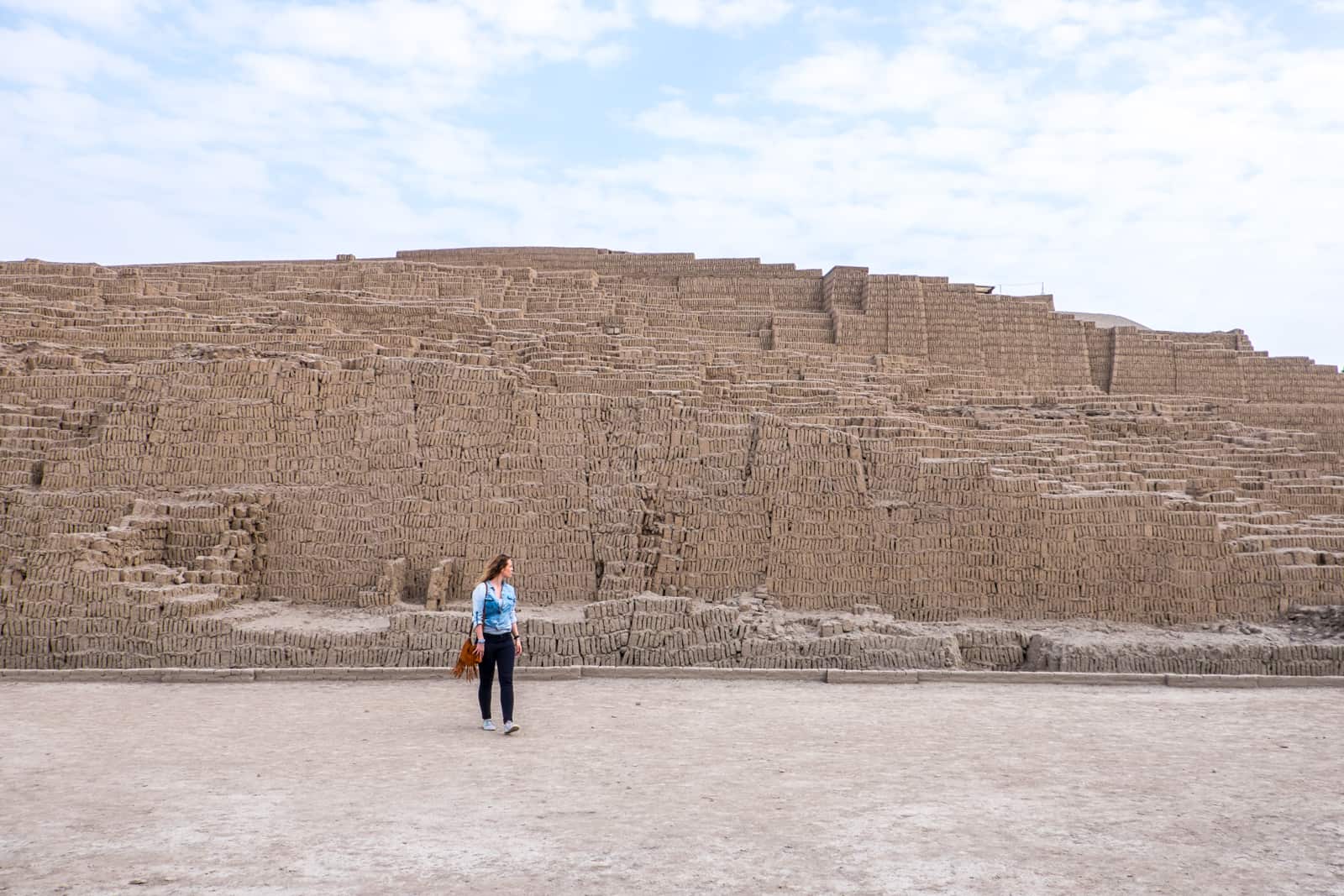
Huaca Pucllana Inca Ruins in Lima.
Paracas
Coastal Paracas may not have much going on apart from its super chill vibes, but people come here to head out on a speedboat to visit the protected Ballestas Islands. Dubbed the “Poor Man´s Galapagos”, this is a chance to spend two hours spotting wildlife, including pelicans, penguins, birds and sleepy sea lions in the Paracas National Reserve.
The contrasting sweeping desert plains of Paracas National Park, marked by cliff drops and jagged rock formations, are also another highlight. However, there are plenty of nature-focused things to do if you decide to stay for a few lazy days.
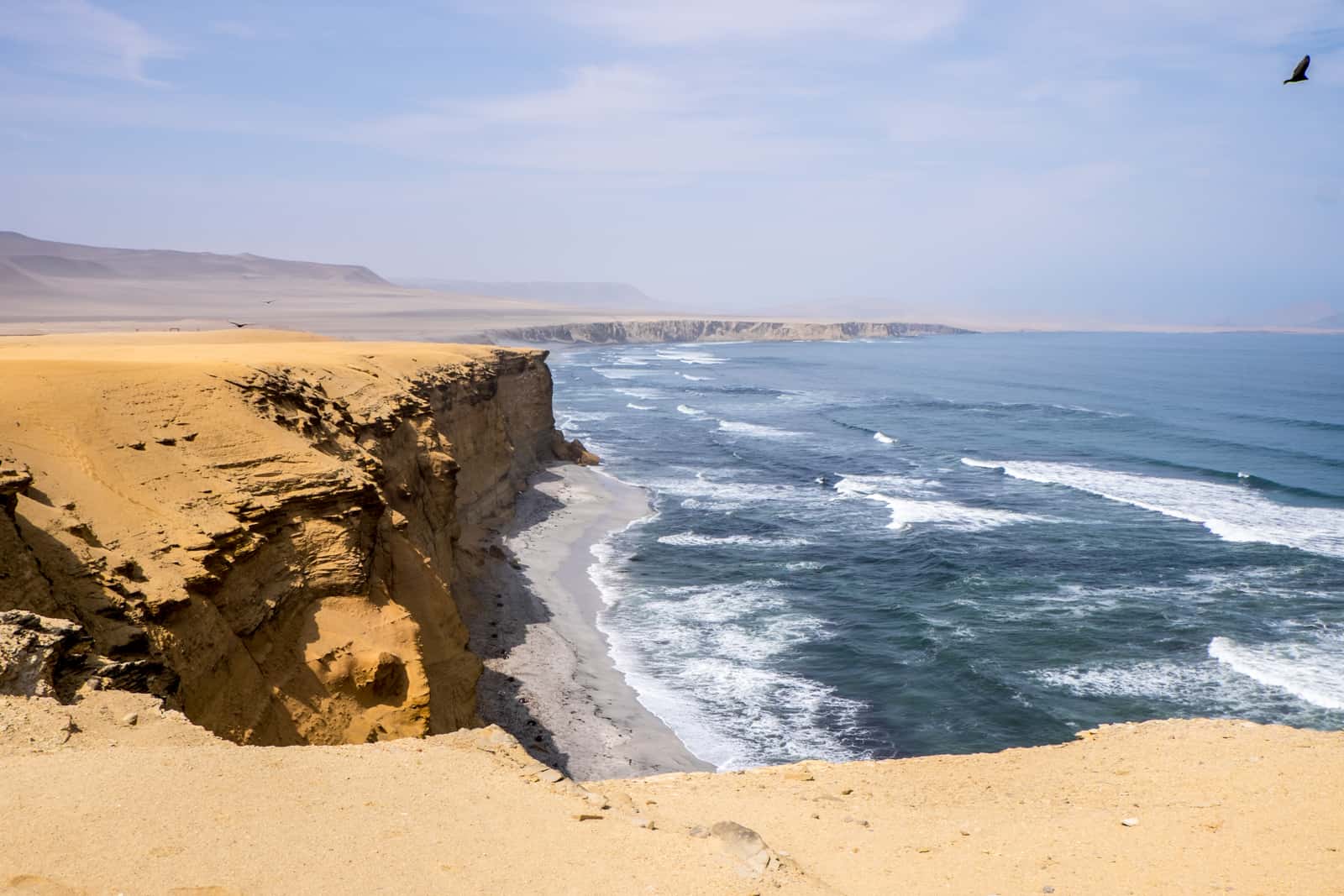
The coastline of Paracas National Reserve, Ballestas Islands, Peru.
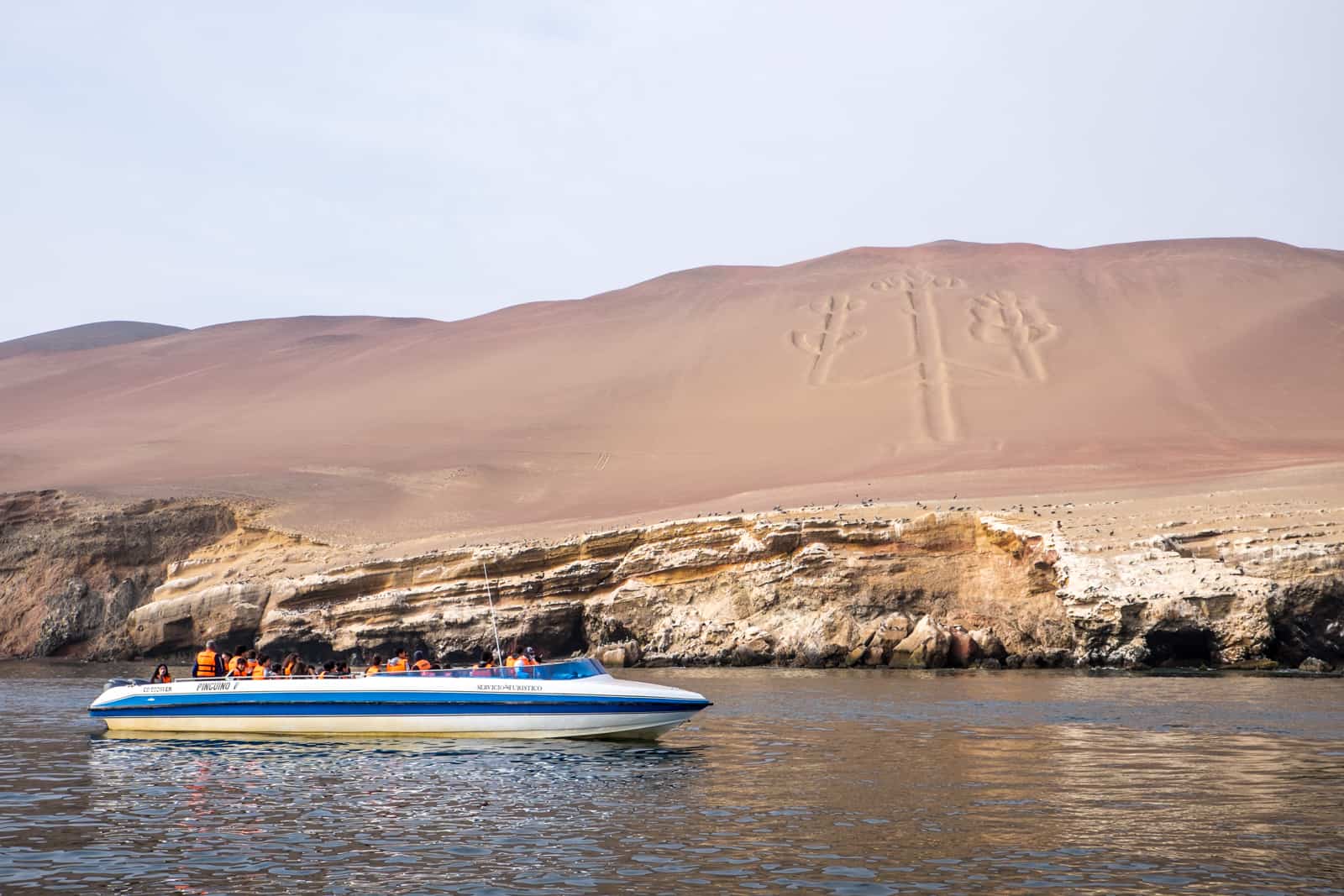
See the famed Paracas Candelabra geoglyph rock carving.
Huacachina
Huacachina is all about the mighty sand dunes. As soon as you arrive in this desert oasis town, you’ll realise it’s surrounded by a ring of golden mounds.
The best way to experience them is by strapping yourself into a sand buggy and enjoying a fast and bumpy nature coaster ride to some of the highest points and stomach-churning ploughs down. Alternatively, you can also learn how to Sandboard down, which is a real thrill (beginner tips here). Travellers also come here to indulge at the nearby Pisco vineyards.
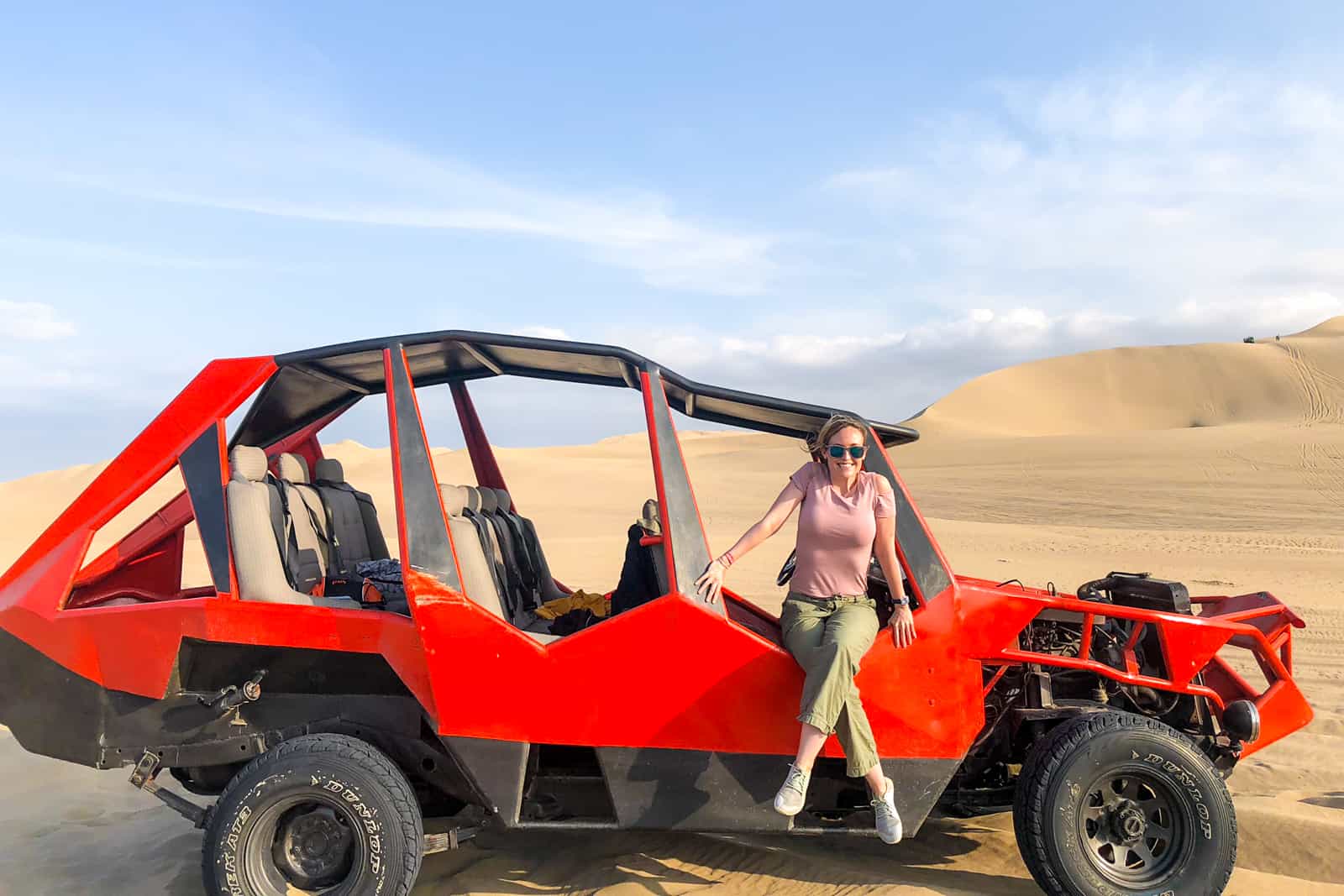
The sand buggy ride to the Huacachina sand dunes in Peru.
Nazca
The 2,000-year-old geometric Nazca Lines are a world-famous site, despite the fact we still do not know exactly why these markings in the desert were created. This UNESCO world heritage site remains a mystery, and you can’t pass through without taking a look for yourself.
Three of the Nazca Lines can be viewed for free from a tower that is perched along the Trans American Highway. Still, the best way to see all the mysterious shapes and symbols is via a dizzying plane flight as you curve around the desert basin trying to spot the spider, condor, monkey, whale and astronaut.
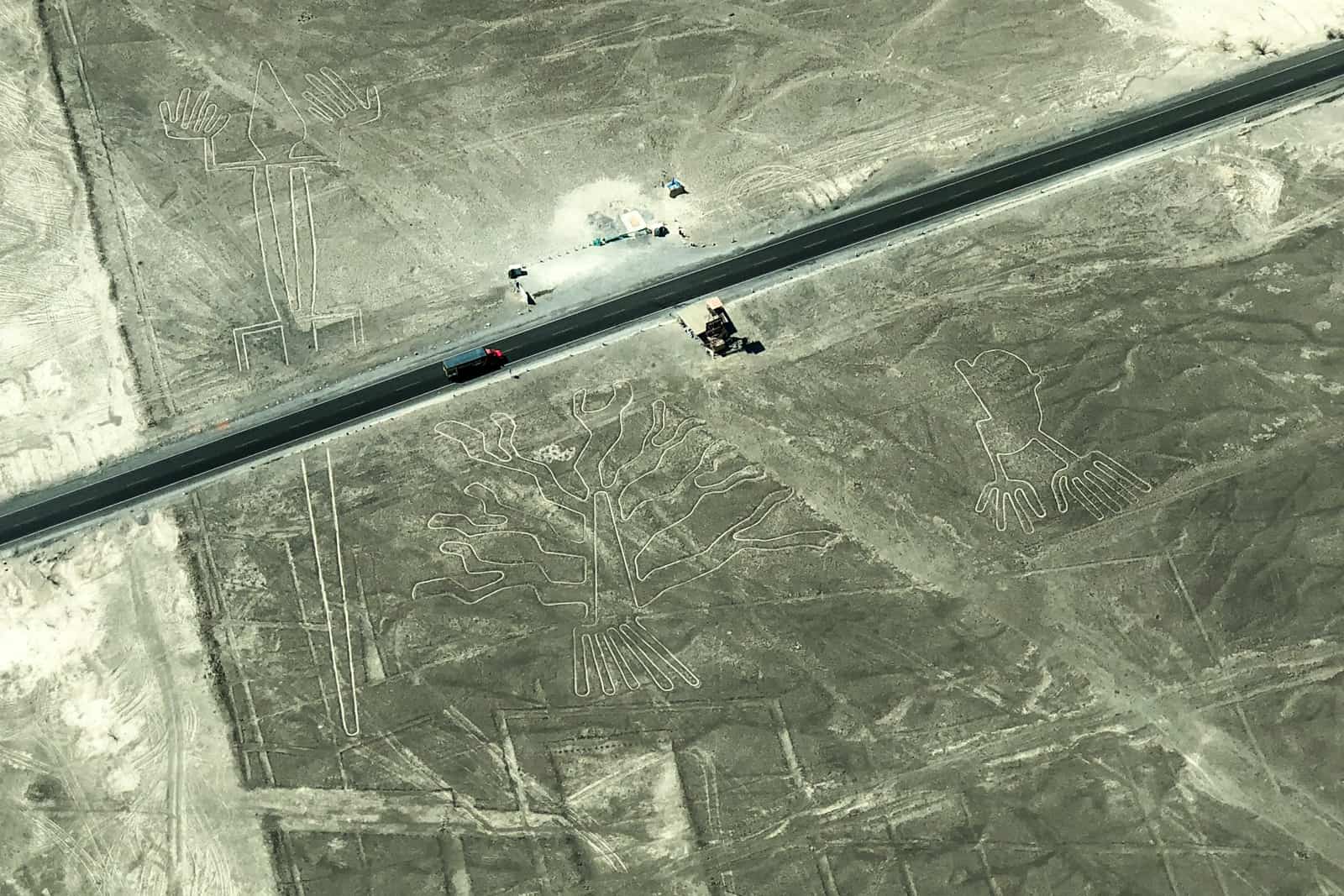
View from the plane shows a road cutting through some of the geoglyphs carved into the Nazca Desert. A viewing tower has been set up for those who do not want to fly over.
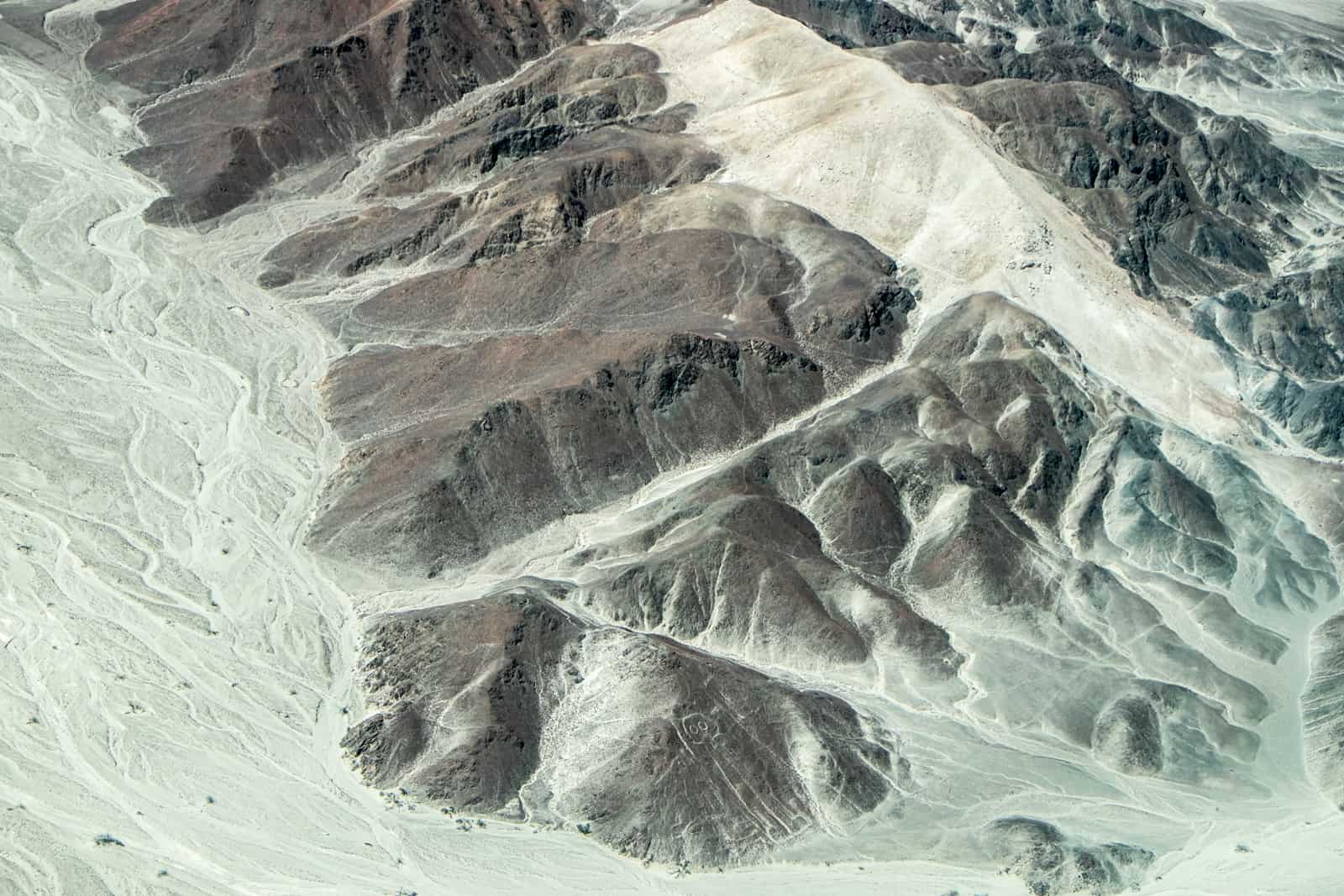
Can you spot the astronaut? It’s one of the famed desert soil-carved Nazca Lines in Peru.
Arequipa
Arequipa is a beautiful city decked in colonial architecture, with a panorama of mountain peaks, including the dominant Misti volcano. For a historical introduction and some hidden neighbourhoods and viewpoints, take the free walking tour offered daily.
A full day alone can be granted to the Santa Catalina Convent (Monasterio D Santa Catalina), dubbed “a city within a city.”
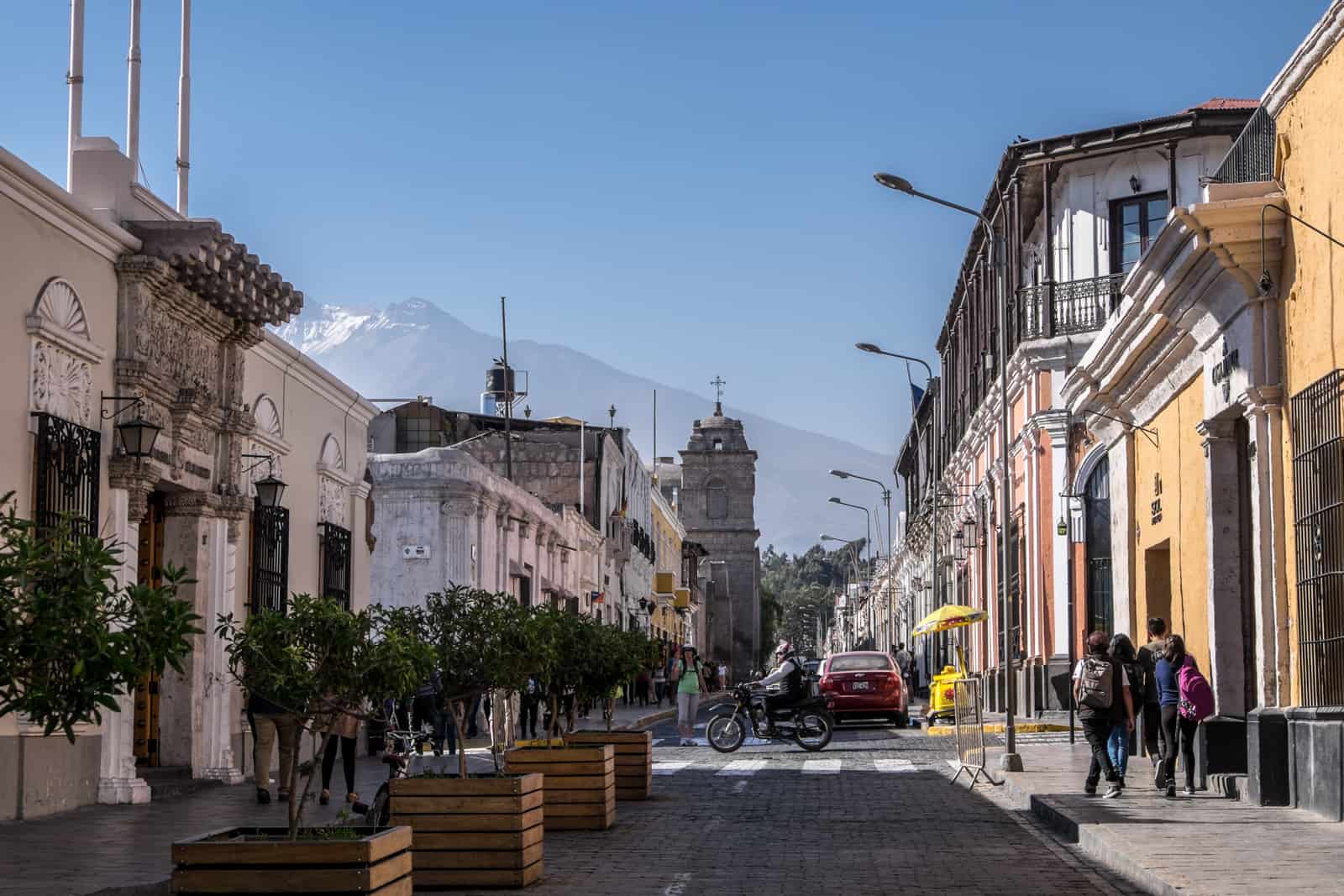
The Misti Volcano can be seen from the streets of Arequipa, Peru.
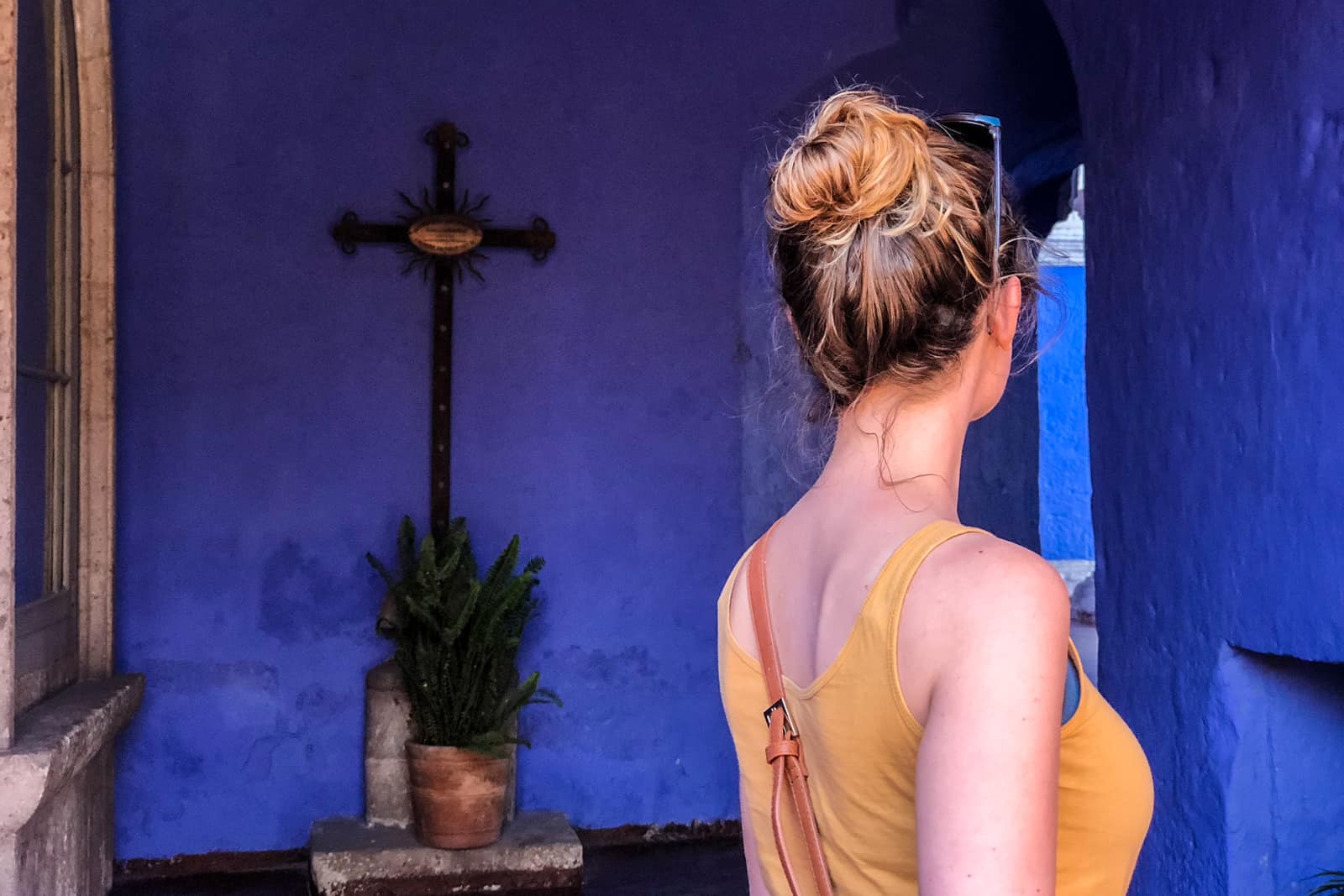
Visit the Santa Catalina Convent in Arequipa.
Colca Canyon
Four hours from Arequipa is Colca Canyon – the second deepest canyon in the world that is said to be twice as deep as the Grand Canyon.
Attracting everyone from day-trippers to hardened trekkers, not only can you view the Andean Condor birds in flight from above, as well as find majestic viewpoints to surrounding volcanoes, but also you can hike down into the Canyon, stay overnight in the oasis below and hike out at sunrise. It was a painful, but unforgettable landscape to experience.
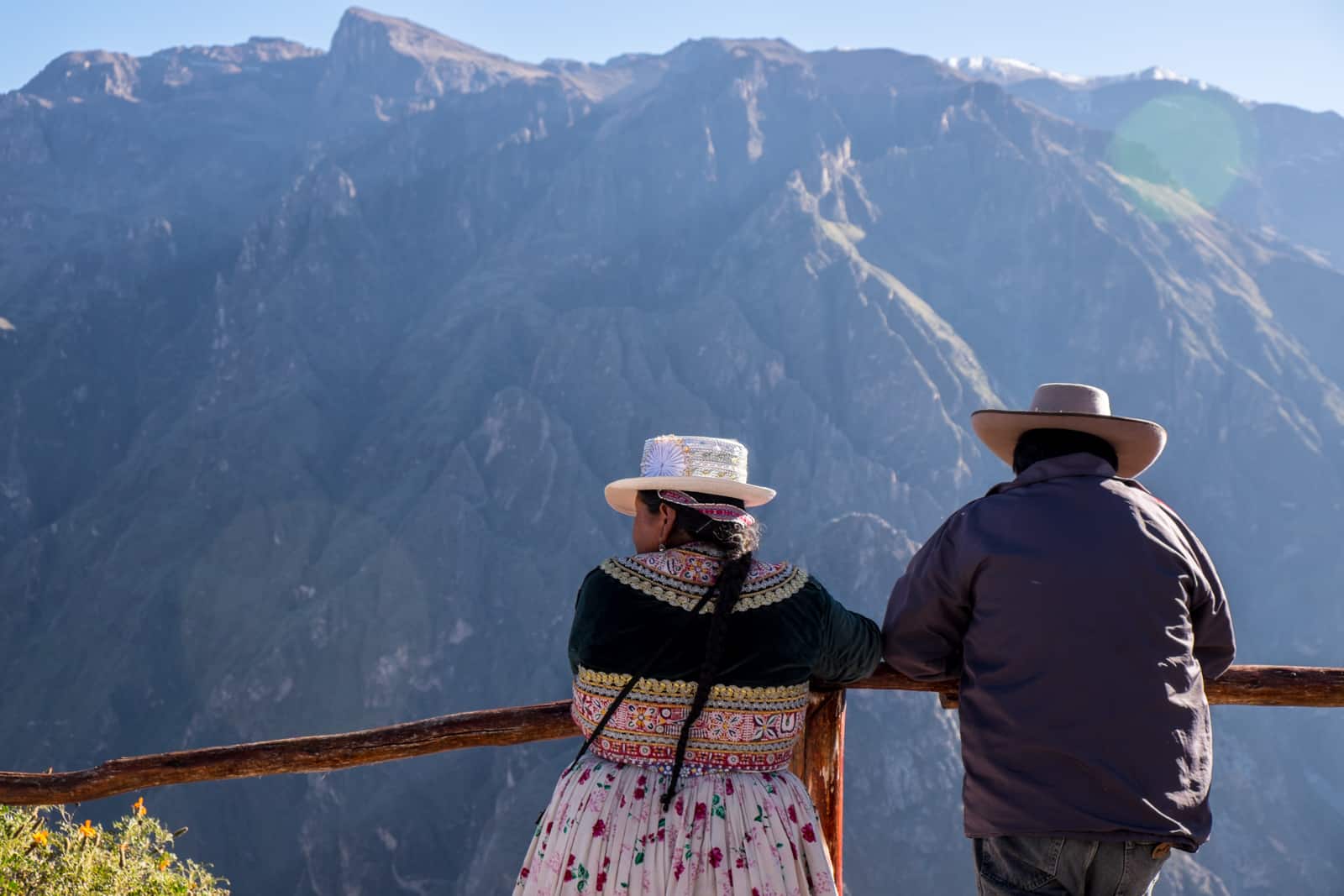
Join the locals visiting Colca Canyon on a day trip from Arequipa, Peru.
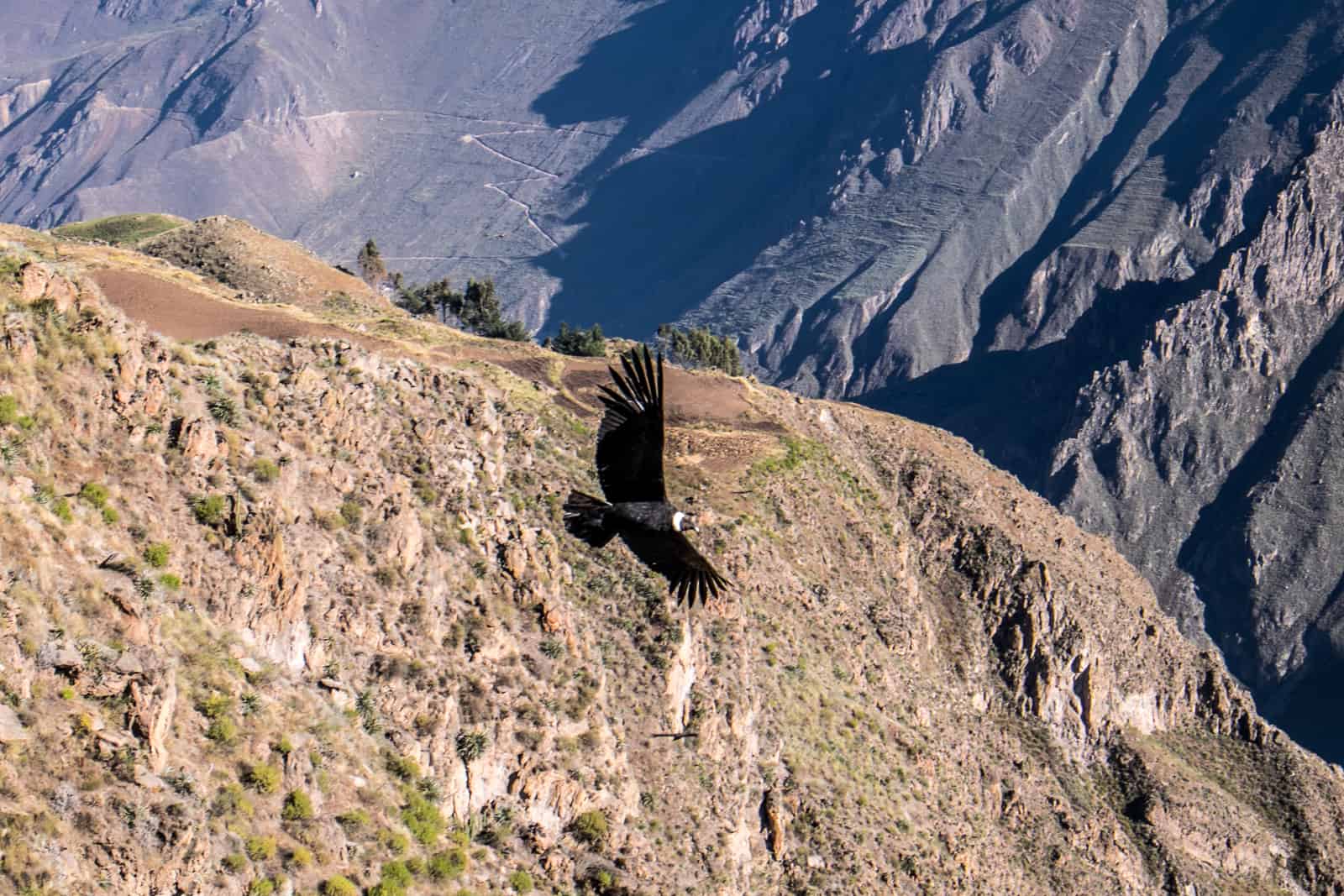
A condor in flight in the Colca Canyon – a highlight of a visit here.
Puno and Lake Titicaca
Puno is famous for Lake Titicaca – the highest navigable lake on Earth at over 3,800 meters above sea level.
It’s here that people visit the man-made floating reed islands, with the chance to stay overnight with a local family on one of the remote islands a bit further out. I recommend this option if you have time, as I found the half-day and day tour trips set up only for tourists. Not to mention it has induced a culture of begging, even amongst the local children.
Others come to Puno, extending their lake visit as a means to also connect into Bolivia via Copacabana.
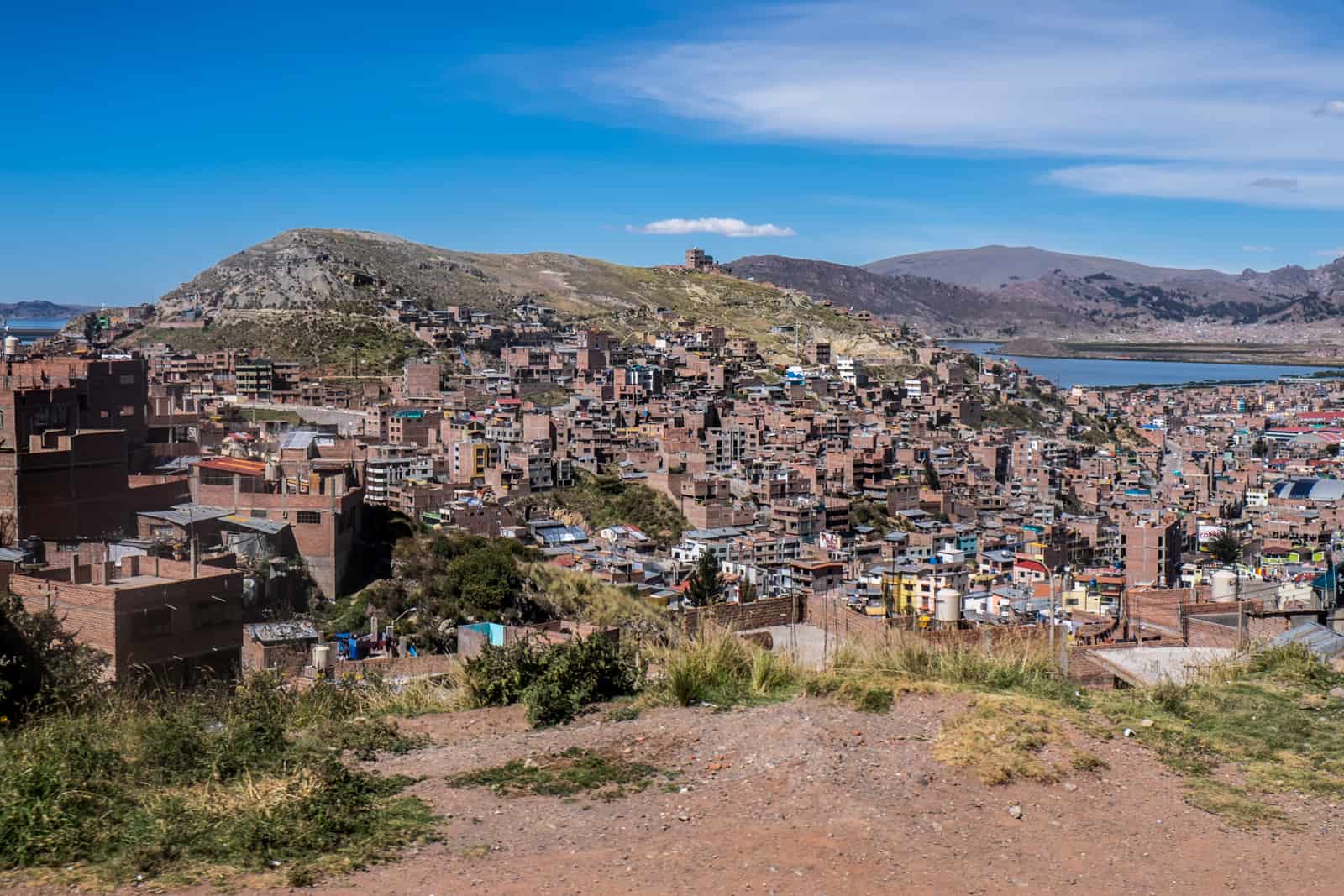
Visit Puno to see Lake Titicaca.
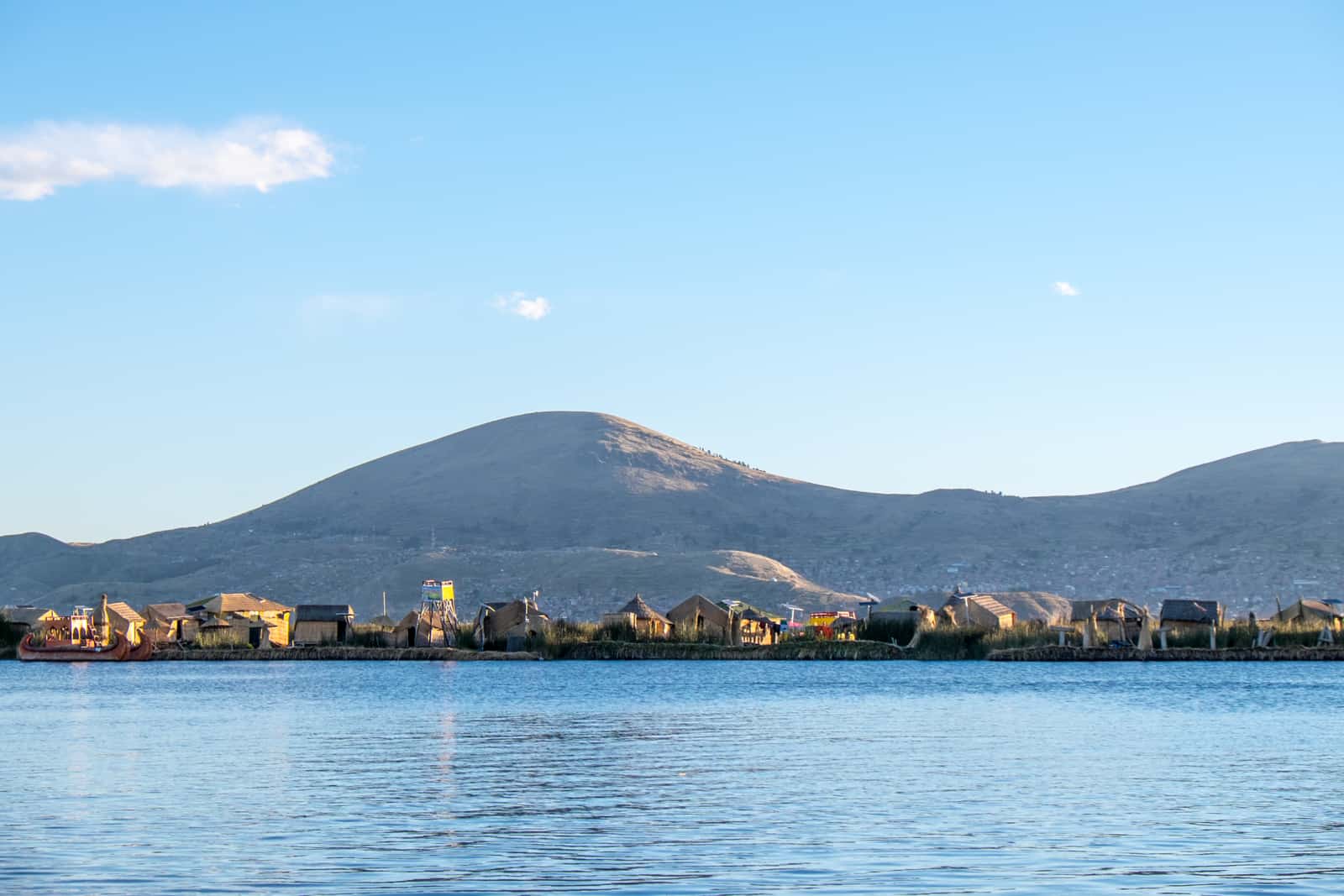
Travel to Peru and visit the unique reed houses on the floating islands on Lake Titicaca, Peru.
Cusco and the Sacred Valley
Cusco, once the capital of the Inca Empire, is, of course, the starting point for those on their way to the famed Machu Picchu – the grand highlight of any Peru trip.
However, there’s more to Cusco than a gateway for those making the pilgrimage to the ancient Inca Site. The centre of Cusco itself is full of sites, including Colonial architecture and stone walls and ruins of Inca days that line the steep cobble-stoned streets.
Fun tours in Cusco can be found in abundance if you want deeper historical and cultural insights. Hip coffee shops, vegan cafes and restaurants, independent design stores and funky hangouts define the city, especially in the bohemian San Blas neighbourhood.
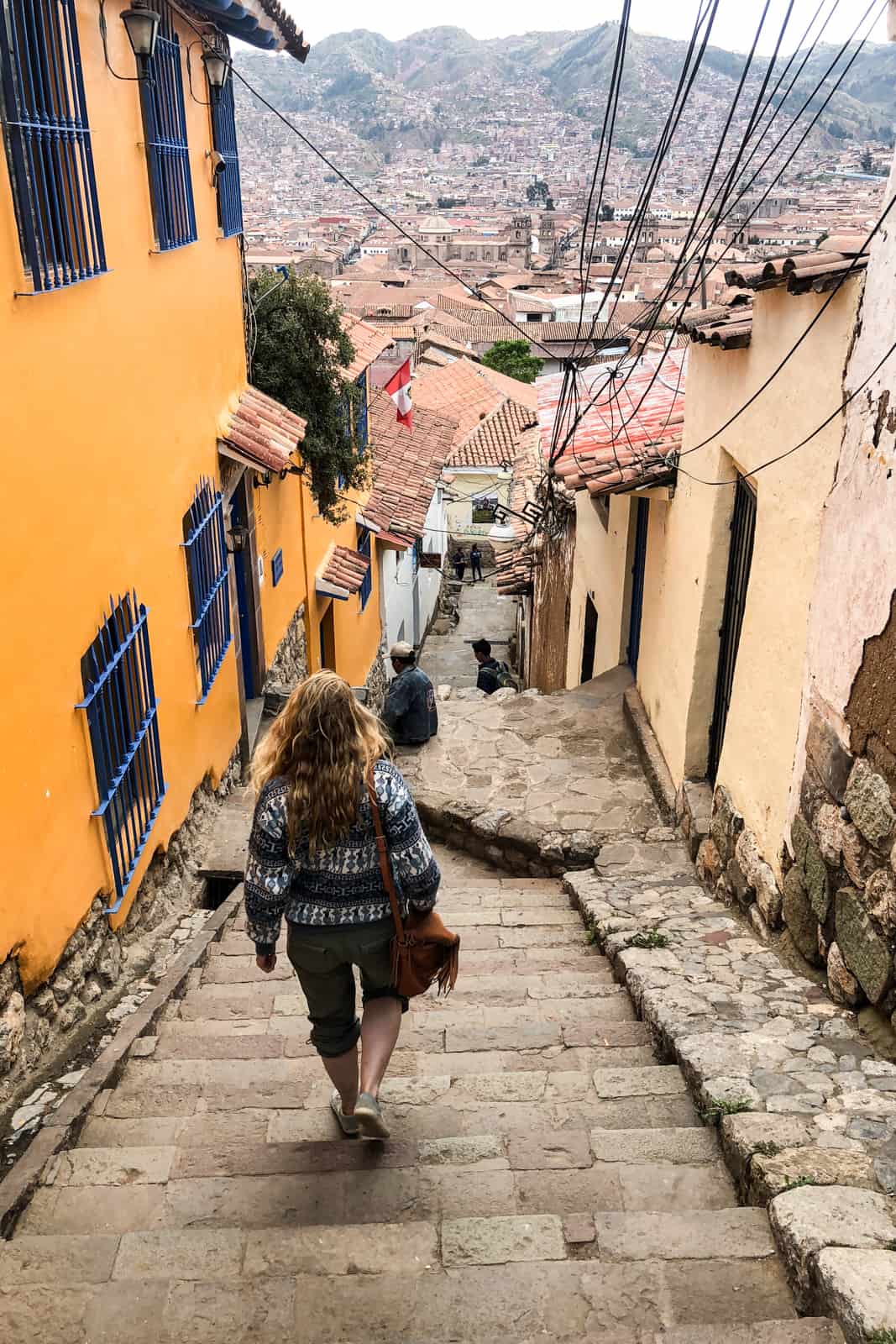
The high altitude cobbled streets of Cusco valley.
There are also a few key sites and treks that make for great day trips from Cusco, including.
The Salinas Salt Ponds are a terrace system of evaporated salt ponds a short drive from the town of Maras, located around one hour outside of Cusco. A man-made layered landscape in the Sacred Valley, these salt basins have been in use since the days of the Incas, with a section now open to the public to marvel at.
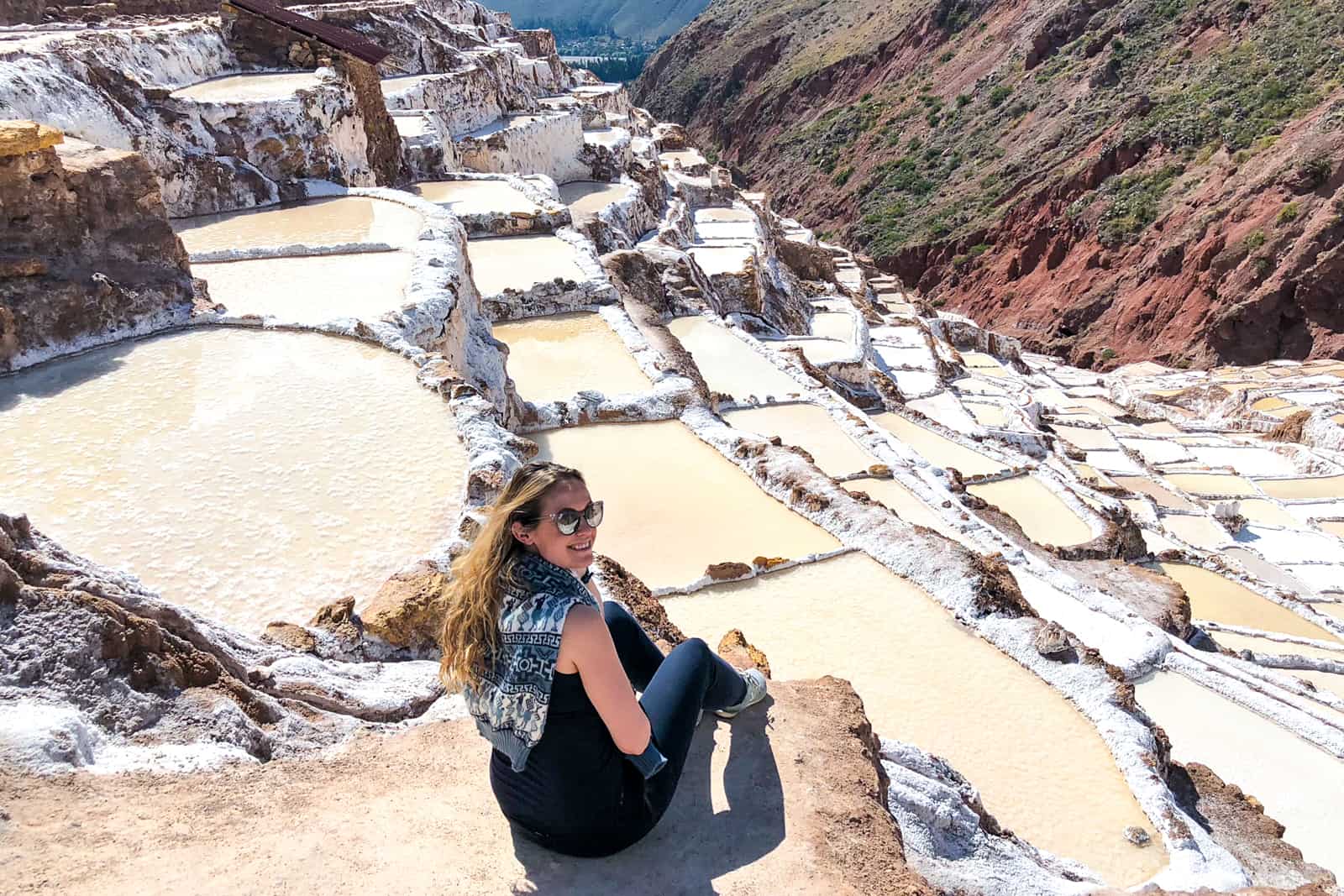
One of Peru’s best places to visit is the Salinas Salt Ponds in the Sacred Valley, Cusco.
Moray is an archaeological site of ringed Inca ruins in a remote area near Maras (and easily combined with Salinas). Defined by its circular terraces at a plateau of 3,500 metres, it is believed this was used for agricultural research, with the different terrace levels having unique microclimates.
Sacsayhuaman is a hilltop Inca citadel that sits on the northern fringes of Cusco and is said to be a fortress overlooking the city. It is known for its huge dry stones that fit together in the same way as those on the old Inca walls in Cusco – without any mortar or filling such as soil or clay.
Things to Do in Peru – Further Suggestions
Free Walking Tours in Peru
In Lima, Cusco and Arequipa, I used free walking tours (payment based only on tips). I used the company Free Walking Tour Peru in both Lima (for Downtown Lima and Barranco walking tours) and Cusco (for an orientation and history walk) and highly recommend them both for cultural and historical insights, as well as a good balance of fun.
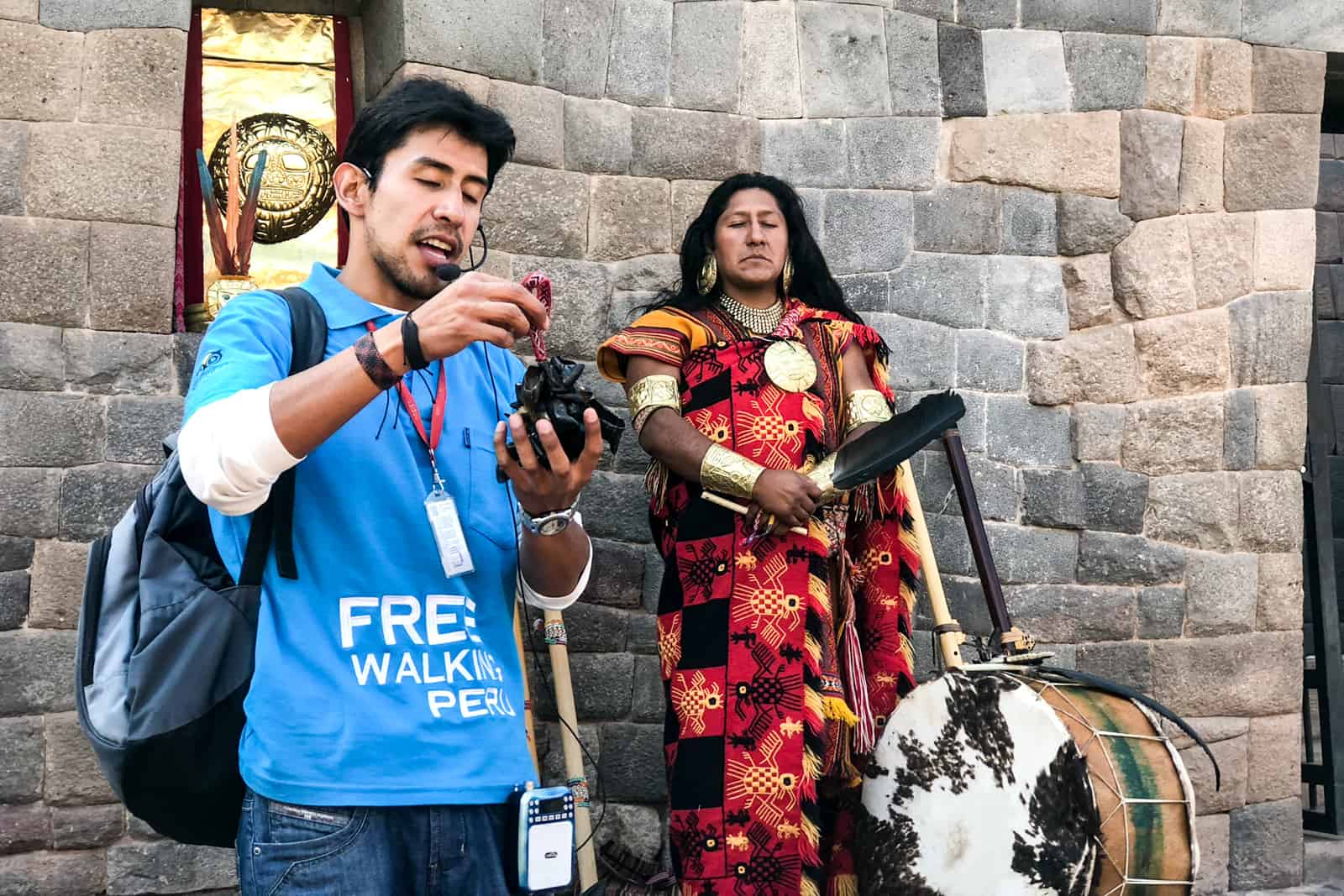
Go on a free walking tour in Cusco for orientation and an introduction to Inca history and culture.
Booking Day Trips and Experiences
Most hotels and hostels offer ideas and services for excursions and experiences. Many are packed full of maps and leaflets detailing local companies. Others offer their own, like cooking classes and Spanish lessons. When booking day trips or short excursions, I used Find Local Trips, one of South America’s largest and most trusted tour booking platforms and GetYourGuide
Where to Stay in Peru
I lived it up in a luxury hotel and stayed in a dorm and private room at a hostel. There’s a mix of everything in the city to suit all budgets and preferences of atmosphere from quiet to party.
Where to Stay in Lima
- Casa Andina Premium – Beautiful boutique-style hotel on a quiet street just a few blocks from Parque Kennedy.
- Pariwana Hostel – One of the hostels you hear about on the grapevine. Close to the beach and complete with terrace and bar, table tennis table and continental breakfast.
- Alpes Lima – I stayed in both their dorm room property (home to the rooftop bar) and their second property two blocks away that has private rooms and a quieter environment.
- Pool Paradise Lima – The only hostel in Miraflores with an outdoor pool.
- The Point – For those wanting to hang out in the arty, hip neighbourhood of Barranco.
Where to Stay in Paracas
- Paracas Backpackers House – More chilled, family-run hostel just a five-minute walk to the coastline.
- Kokopelli Backpackers – More of a party hostel, with its own pool and lively bar.
Where to Stay in Huacachina / Ica
- Banana’s Adventure Hostel – New, funky, modern touches and great atmosphere. The place I wish I had stayed after finding it.
- Casa de Arenas – The biggest hostel in this tiny town, complete with bar and pool but is a little worn and the staff attitude isn’t very welcoming.
- Le Casa de Bamboo – The quiet traveller’s option, complete with a small bar.
Where to Stay in Nazca / Nasca
Not many people stay overnight in Nazca. Instead, they pass through on the way to Arequipa. For those wanting to chill here and break up the journey, the following places were recommended.
- Nazca Travel One – Central, family-run establishment.
- Hotel Alegria – Considered one of the best hotels in this area, and the bonus is it has a pool.
Where to Stay in Arequipa
- Casa de Avila – I adored this cosy, quiet 3-star hotel and treated myself to four nights here (at only $40 a night) to get some proper rest pre and post-Colca Canyon trek. It’s less than a 10-minute walk to the very centre and the Plaza de Armas. You can also take a Peruvian cooking class here.
- Wild Rover – The party hostel with a pool. Part of the Irish hostel chain in Peru.
- Flying Dog – The quieter, chilled out hostel with lounge areas and easy access to the centre of the city.
Where to Stay in Puno
- Suites Independencia – We left our bags here as we explored on day trips before catching the night bus, but a friend stayed overnight so I got to see the rooms. Basic, spacious room right in the very centre of town.
- Pacha Suites is also a centrally based accommodation and was a mid-range option that was recommended.
- Staying with a local family found on Airbnb was an option fellow travellers recommended me for those wanting a proper homestay experience on Lake Titicaca.
Where to Stay in Cusco
- Casa del Carmen – A family-run, quiet, cosy residence located in the cool arty district of San Blas. Carmen is very motherly and always on hand to help, although the only downside is you may be asked to move around if you are there for many days as there doesn’t seem to be a set system in place for the rooms. But for $25 for a private room in central Cusco, I wasn’t going to complain too much.
- Wild Rover – The party hostel option in Cusco for revelling travellers.
- The popular Kokopelli Backpackers chain in Peru also has a base in Cusco. It’s right on the main square, although it can be pricey.
Search and Book a Hotel in Peru
(function(d, sc, u) {
var s = d.createElement(sc), p = d.getElementsByTagName(sc)[0];
s.type=”text/javascript”;
s.async = true;
s.src = u + ‘?v=’ + (+new Date());
p.parentNode.insertBefore(s,p);
})(document, ‘script’, ‘//aff.bstatic.com/static/affiliate_base/js/flexiproduct.js’);
The Best Way to Visit Machu Picchu and the Sacred Valley
Getting to Machu Picchu is undoubtedly the highlight of Peru, and figuring out the best treks and Machu Picchu tours and days trips is the eternal question in planning.

Trek through the mountains of the Sacred Valley to reach Machu Picchu.
Machu Picchu Treks
The Inca Trail to Machu Picchu
The most popular of all, this four-day trek takes you through various communities and the ancient Incan ruins of the Sacred Valley, set within stunning Andean scenery. The final day marks the start of a pre-dawn to reach the Sun Gate before sunrise as you enter the magnificent Machu Picchu.
A lifeline of Peru tourism, it is important to visit Machu Picchu as responsibly and ethically as possible.
G Adventures Inca Trail Tours – Awarded the best operator for the Inca Trail route.
Inca Trail 4-Day Trek – A highly rated trek on GetYourGuide with a local operator.
Huayna Picchu Hike — This entry ticket grants access to the 2,693 m peak, which offers elevated views over Machu Picchu’s Inca citadel. Only 400 people per day are allowed to visit Huayna Picchu, so book ahead.
The Salkantay Trek
Dubbed an alternative trek to the Inca Trail, this route crosses the Salkantay Pass at 4600m, following a trail descending into cloud forest. The final point of the hike is to the Inca site of Llactapata, where you get the first look at Machu Picchu from a distance.
See Salkantay trek dates and book here.
The Lares Trek
This three-day hike through the mountains of the Sacred Valley is more about the untouched natural scenery than Inca ruins, reaching highs of 4800m. The scenic train journey from Ollayntambo to Aguas Calientes completes your trip to Machu Picchu.
See Lares trek dates and book here.
Choquequirao Trek
The off-track, more challenging dense forest trek route is an alternative to Machu Picchu, although many often book this trip as an add on to the Inca Trail.
See Choquequirao trek dates and book here.
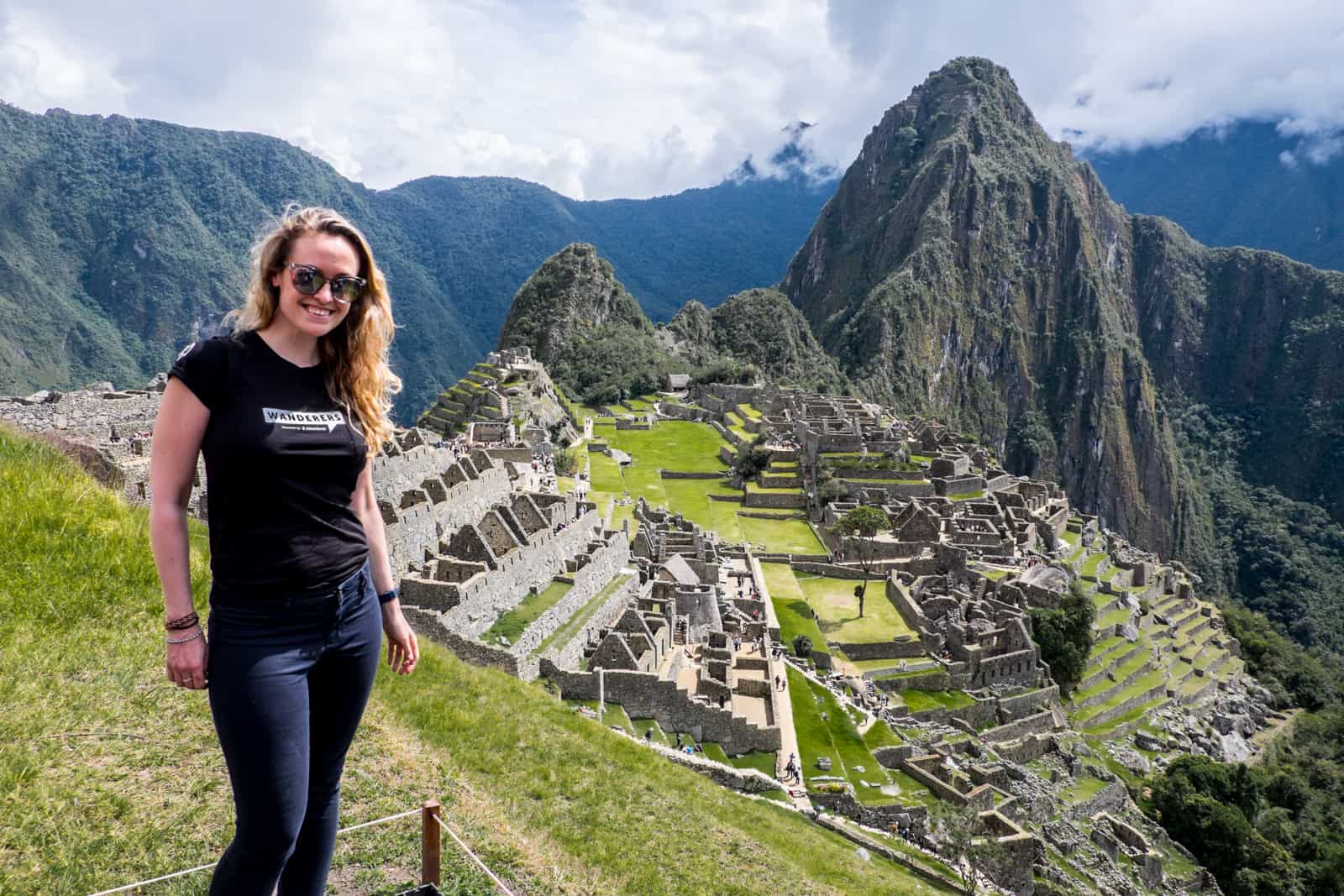
There are plenty of ways to get to Machu Picchu – which will you choose?
Taking the Train to Machu Picchu
For those who do not embark on the Machu Picchu trek that leads you directly to the site by foot, the train is part of the final journey to this ancient Inca citadel, 2430m above sea level.
A train is also a great option for those who do not wish to trek or who cannot fit time for a trek into their Peru itinerary. It means everyone gets a chance to view Peru’s most renowned pilgrimage site, which remains a mystery as to why it was built.
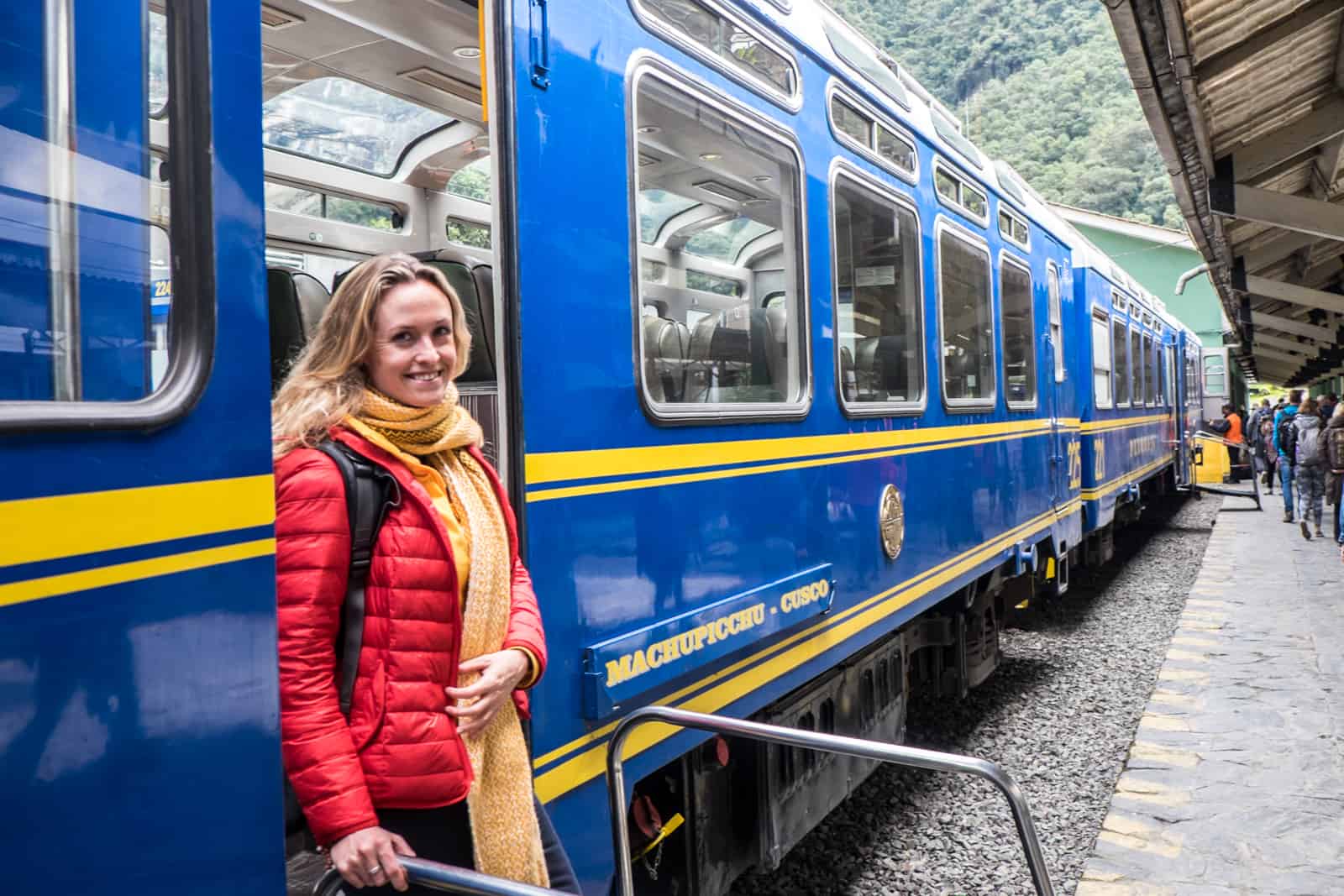
The Peru Rail train to Machu Picchu.
The Peru Rail trains depart from either Porary or Ollantaytambo station, located in the Sacred Valley. It’s an incredibly scenic three-hour and 50-minute or one-hour and 50-minute journey to the station of Aguas Calientes.
From here, you catch a bus up the winding valley to the entrance to the Machu Picchu site. It is advised to book your bus ticket in advance to avoid the long queues.
Permits are only needed for the Inca Trail and not for entrance tickets to Machu Picchu. However, your entrance tickets need to be booked in advance, alongside your train ticket. You must bring your passport – it is checked both at the Machu Picchu entrance and when you board the train.
Tours of Machu Picchu with a registered guide are highly recommended for those who want detailed insight into each aspect of its design and the history of the Inca people.
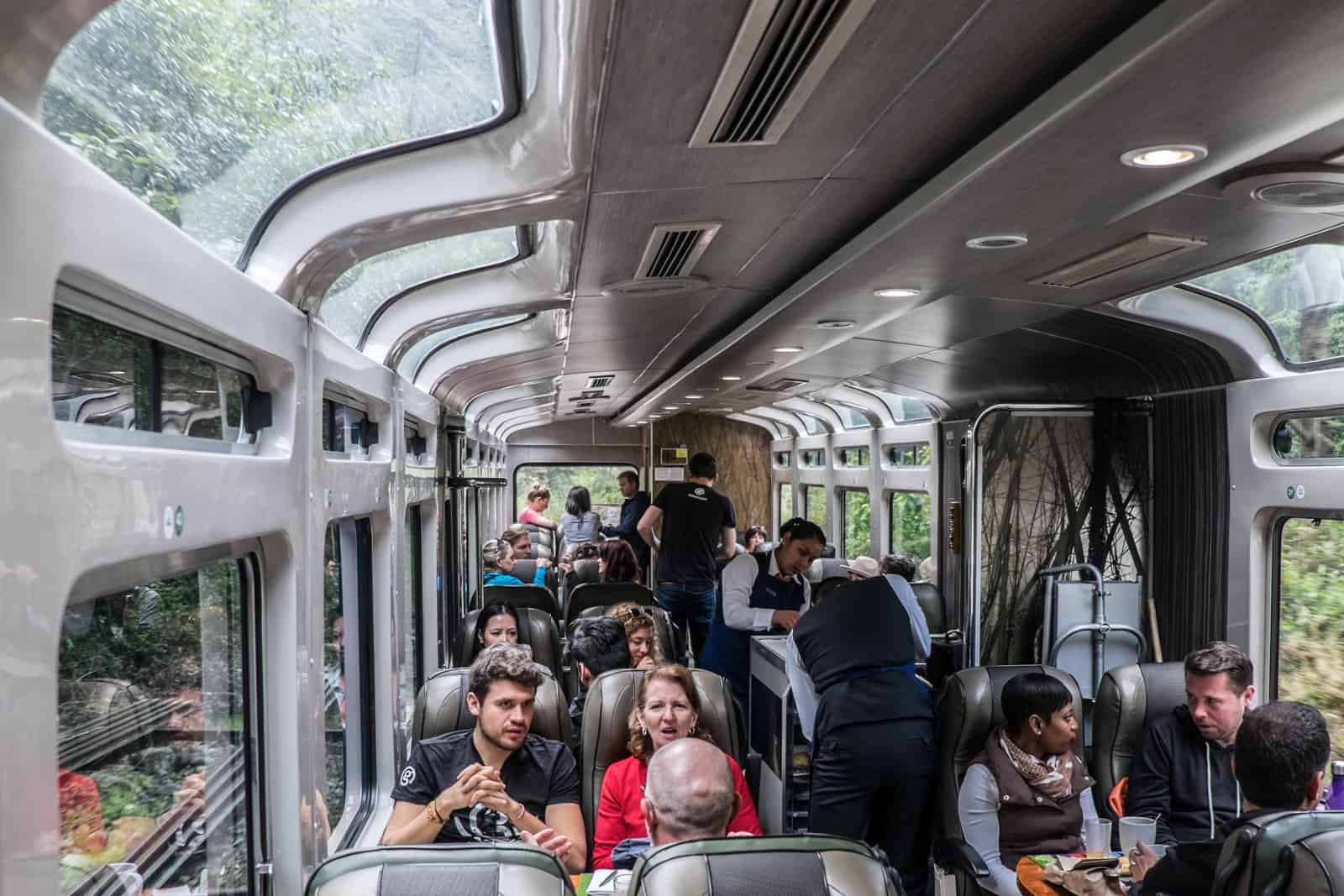
One of the most beautiful train journeys you can take.
Peru Rail Ticket to Aguas Calientes (one way): $50 – $70+
Book Here direct at Peru Rail
Bus Ticket: $12 one way / $24 return
Book Here via the Machu Picchu ticket service or order a pre-booked round-trip bus ticket here.
Machu Picchu entrance ticket: €38 / $46 (152 Peruvian Soles)
Trekking in Peru
Aside from the Machu Picchu treks, Peru has a variety of stunning trekking options tempting the explorer, whether that’s day trips from Cusco, canyons in the south or more technical lagoon hikes in the north.
Laguna 69 Trek
This super scenic trek is located in Huascaran National Park – a two-hour bus journey from Huaraz (nine hours northeast of Lima), which travellers use as a base for this expedition. Forest tracks, snow-capped mountains and steep rocky pathways lead to the magnificent turquoise mountain lagoon at 4500m. This can be completed in one day, but more adventurous souls choose multi-day trekking routes to cover more ground in the region.
Trekking to Rainbow Mountain and Red Valley
Rainbow Mountain has become a very popular trek in recent years after the site was discovered when snow on the mountains melted to reveal the incredible lines of colour, giving the Vinicunca mountain (also called Montaña de Siete Colores – Mountain of seven colours) its name.
A hard day trek, which peaks at 5,000 metres above sea level, the struggle of the altitude is worth it for the unique view at the end. Get yourself on a Rainbow Mountain trek with a very early start to avoid the crowds (we left Cusco at 3 am), and look for a trek that takes in the Red Valley on the way back. *Article coming soon*
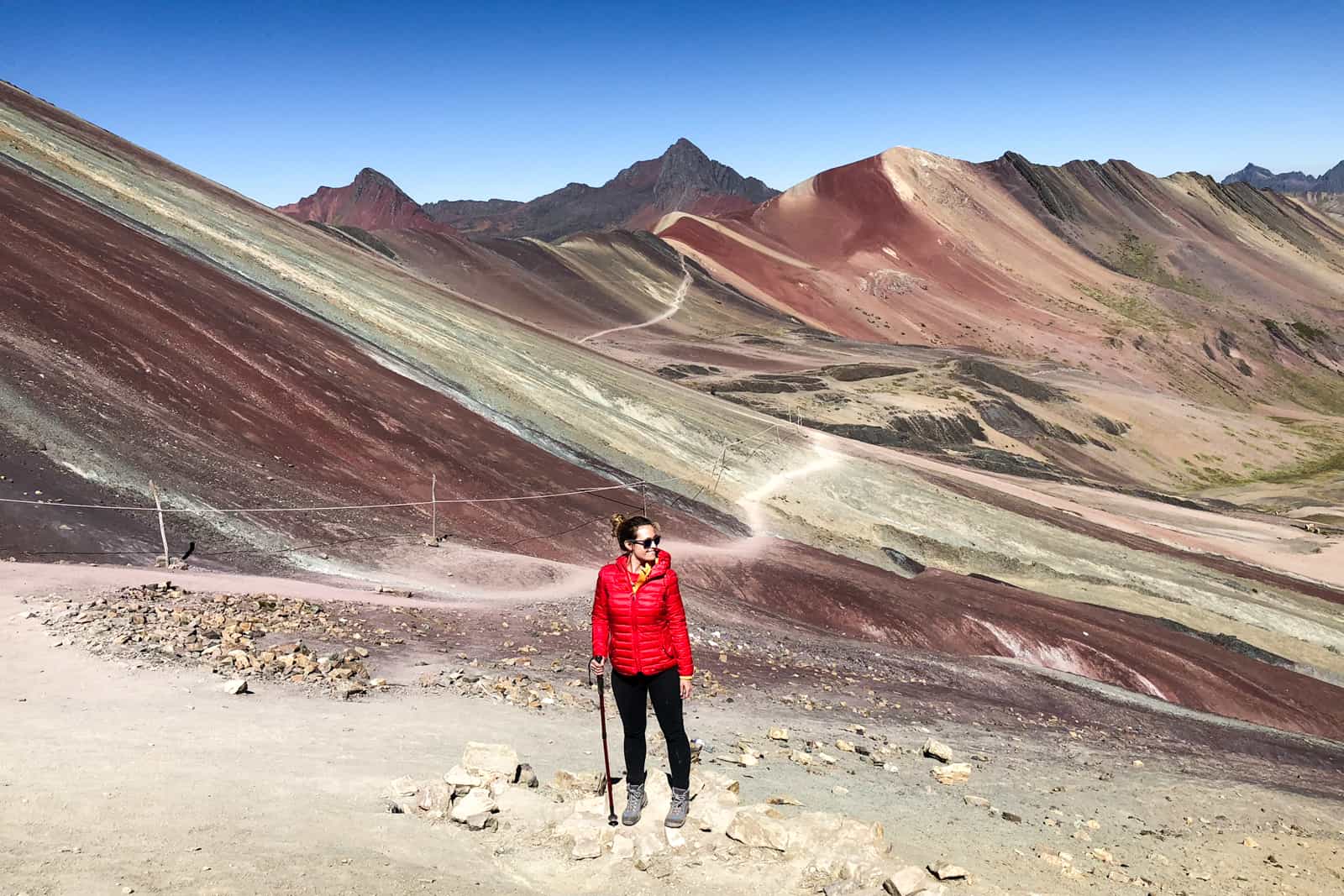
The views you reach when trekking Rainbow Mountain in Peru.
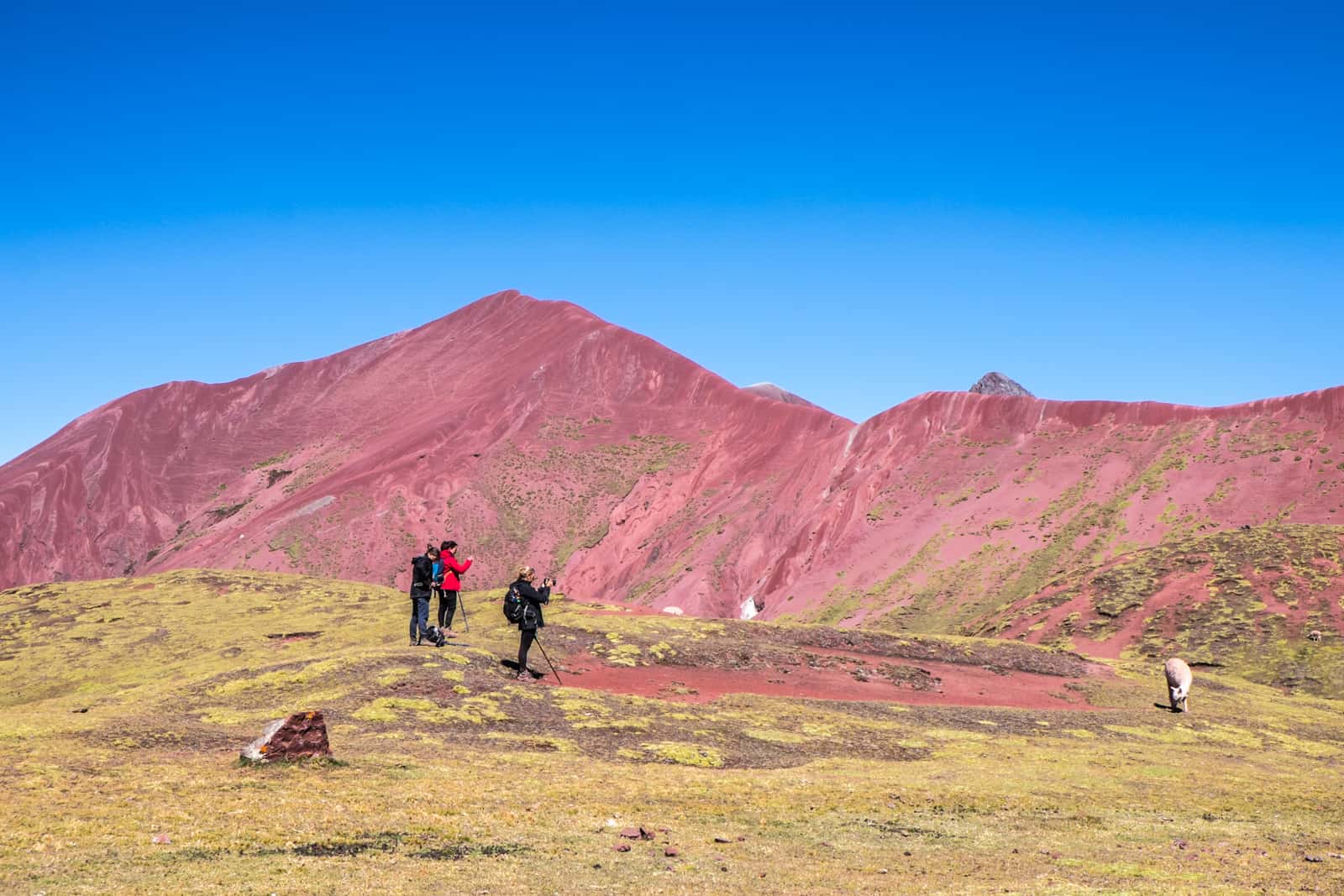
Trekking in the Red Valley on the way back from Rainbow Mountain.
And don’t believe those who say it’s a secret they wish they had kept. Over 1,000 people from the local community are employed, including over 200 people renting the horses. That’s a lot of community regeneration and a community thanking us over and over for sharing this wonderful site.
Trek in Colca Canyon
Trekking in Colca Canyon is no easy feat, yet it is just as much an accolade as it is a chance to be embedded in some of the most incredible scenery in Peru. Why? It’s the second biggest and second deepest canyon in the world.
I chose the two-day trekking option to get more immersed in the canyon landscape and national park, located four hours drive from Arequipa.
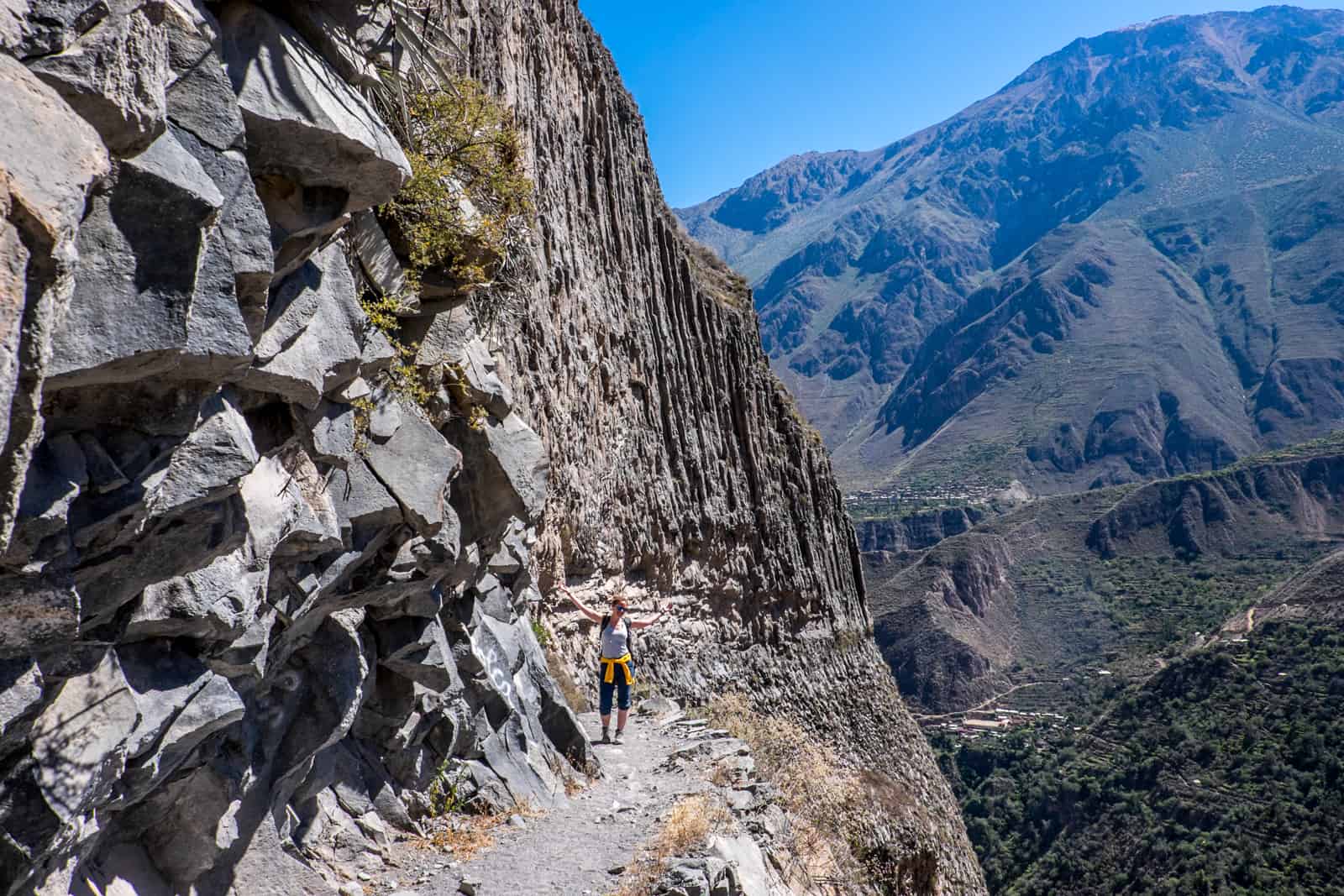
The start of the two-day Colca Canyon trek.
This trekking route also included short stops at the best scenic viewpoints throughout the canyon, before and after the trek, which included long winds down and a VERY steep (and relatively painful) three-hour climb out on the last morning starting at 5 am.
Solo or Group Travel Tours in Peru?
Not everyone wants to travel solo; others may be limited on time and want the ease of having everything organised with a local guide. In Peru, I mixed small group trips with solo travelling.
Peru tours are also a great starting point to cut your teeth on the South America travel circuit, where a tour might be just the familiarity and confidence you need to get started. Here’s a taster of some small adventure group tour options and itineraries, including those that mix Peru with neighbouring countries.
Browse and book 50+ Peru tour options here.
Responsible Travel in Peru – Social Impact
In Peru, where differing levels of poverty and corruption still exist, it’s important to travel as ethically minded as possible, where local communities and social enterprises can benefit from your visit
One of the main reasons I was in Peru was to visit a collection of incredible projects of positive social impact in Lima and Cusco; projects where tourism footfall and the money we spend benefit local communities when travelling through. It can also serve as a means of empowerment, helping preserve culture and allowing for the continuation of micro-enterprise within communities as one person’s success can fund another business idea.
Travellers pass through these projects on G Adventures’ small adventure tours in Peru or on their way to Machu Picchu on the renowned Inca Trail trek, or you can also visit these sites independently with a bit more planning.
Positive Social Impact Projects in Cusco and the Sacred Valley
Ccaccaccollo Women’s Weaving Co-op
Ccaccaccollo Women’s Weaving Co-op was G Adventures’ first social enterprise project. While men in the Sacred Valley are often employed in agriculture or as porters for treks, women now have the opportunity to work and continue a beautiful tradition.
Here, travellers have the chance to not only visit the community and see how the weaving co-op is set up but also have a chance to buy a range of handmade souvenirs from jumpers, scarves and items for the home.
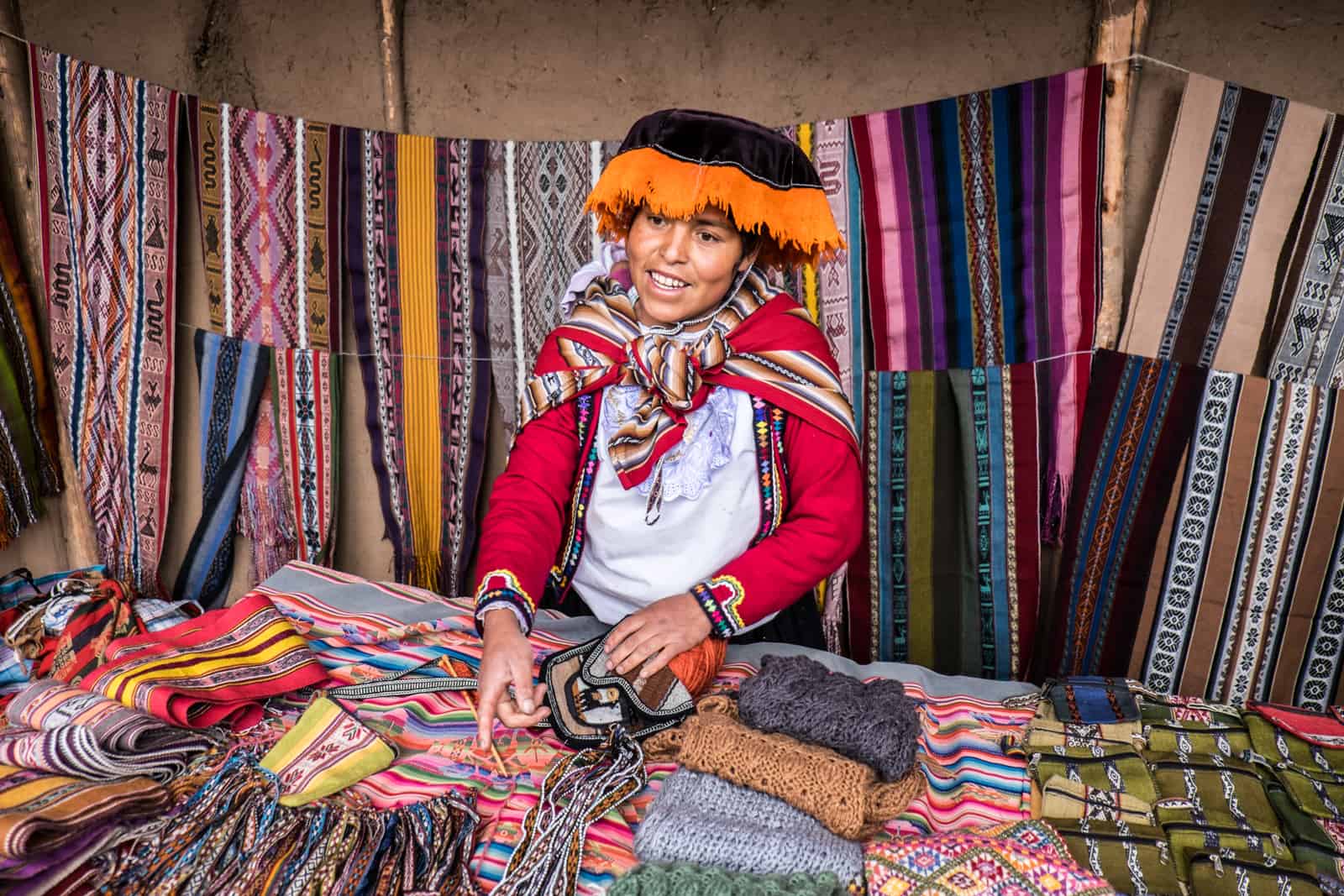
Buy handmade souvenirs from the Ccaccaccollo Women’s Weaving Co-op in the Sacred Valley.
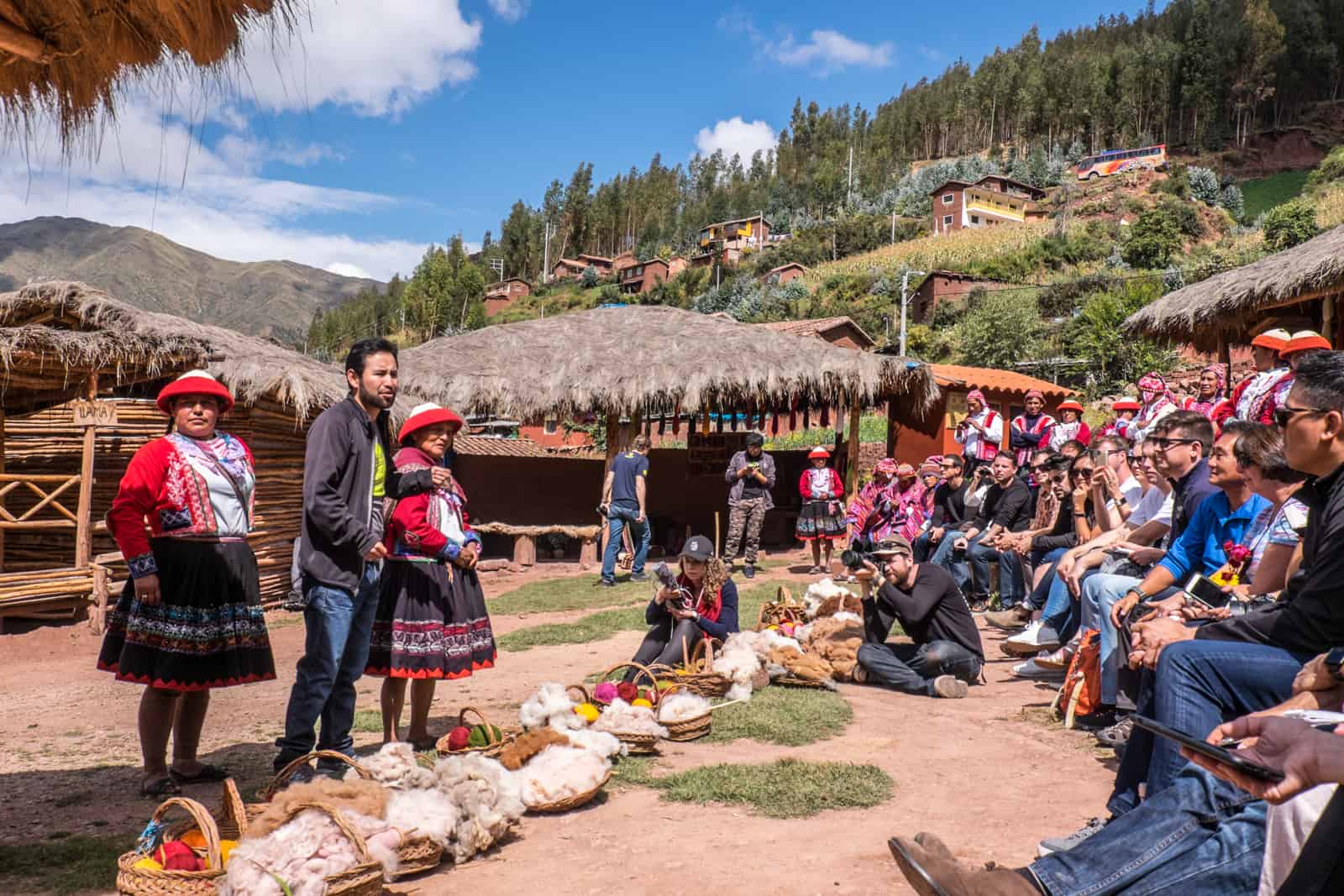
The group learns about how the women of this area continue the beautiful tradition of weaving.
Parwa Community Restaurant
50km from Cusco, in the village of Huchuy Qosqo in the Sacred Valley, a community struggled due to limited access to economic opportunities. Yet travellers were passing nearby, and so an idea was set in place for the construction of the Parwa Community Restaurant.
Over 1,500 G Adventures travellers pass through each month, eating meals using ingredients sourced from local farmers, served by those who are given hospitality training and employment benefits. All income earned by the restaurant is reinvested back into community social projects, including separate micro-enterprises, like Warmicha, which sells various locally made snacks to travellers hiking their way to Machu Picchu.
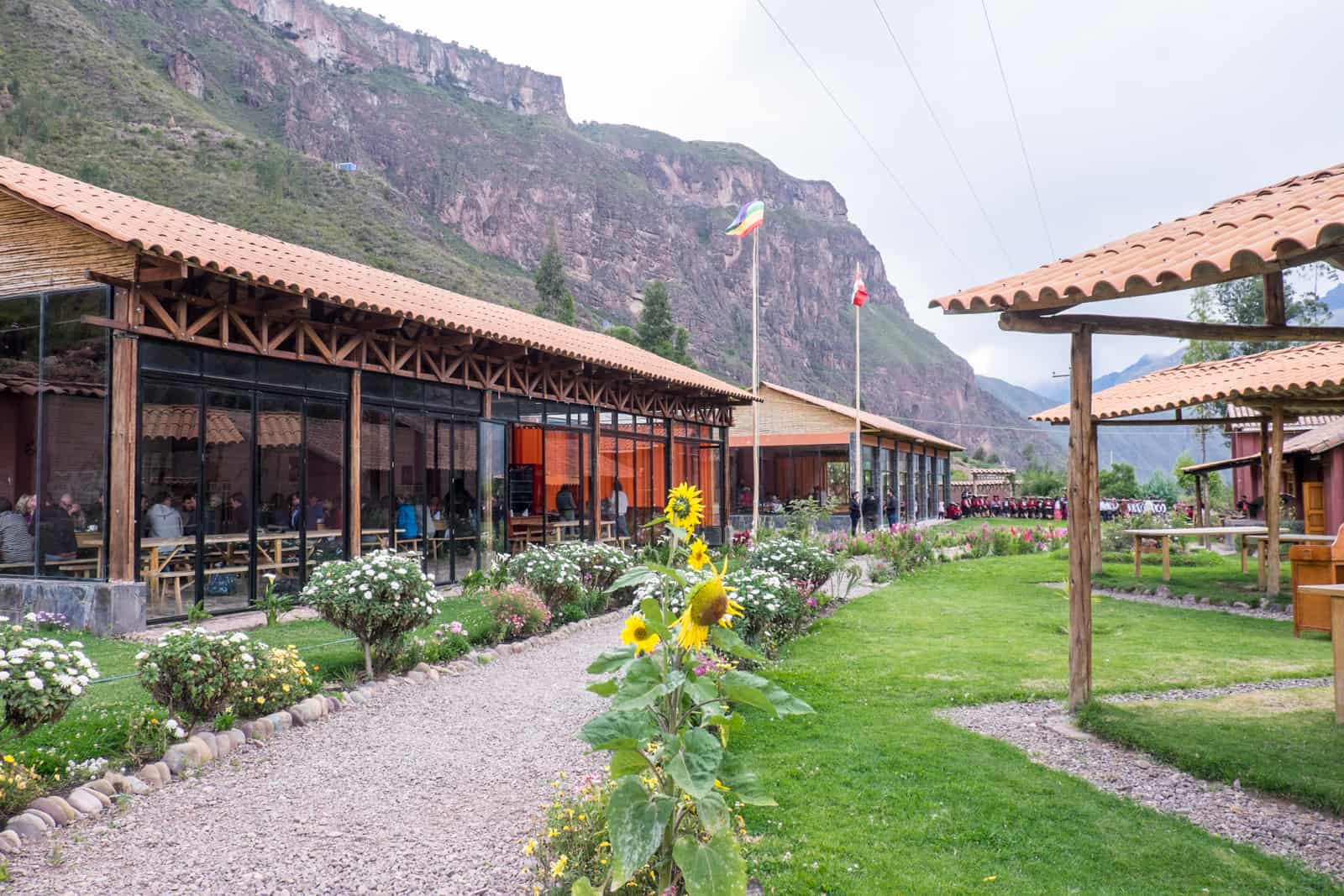
The Parwa Community Restaurant in the Sacred Valley near Cusco.
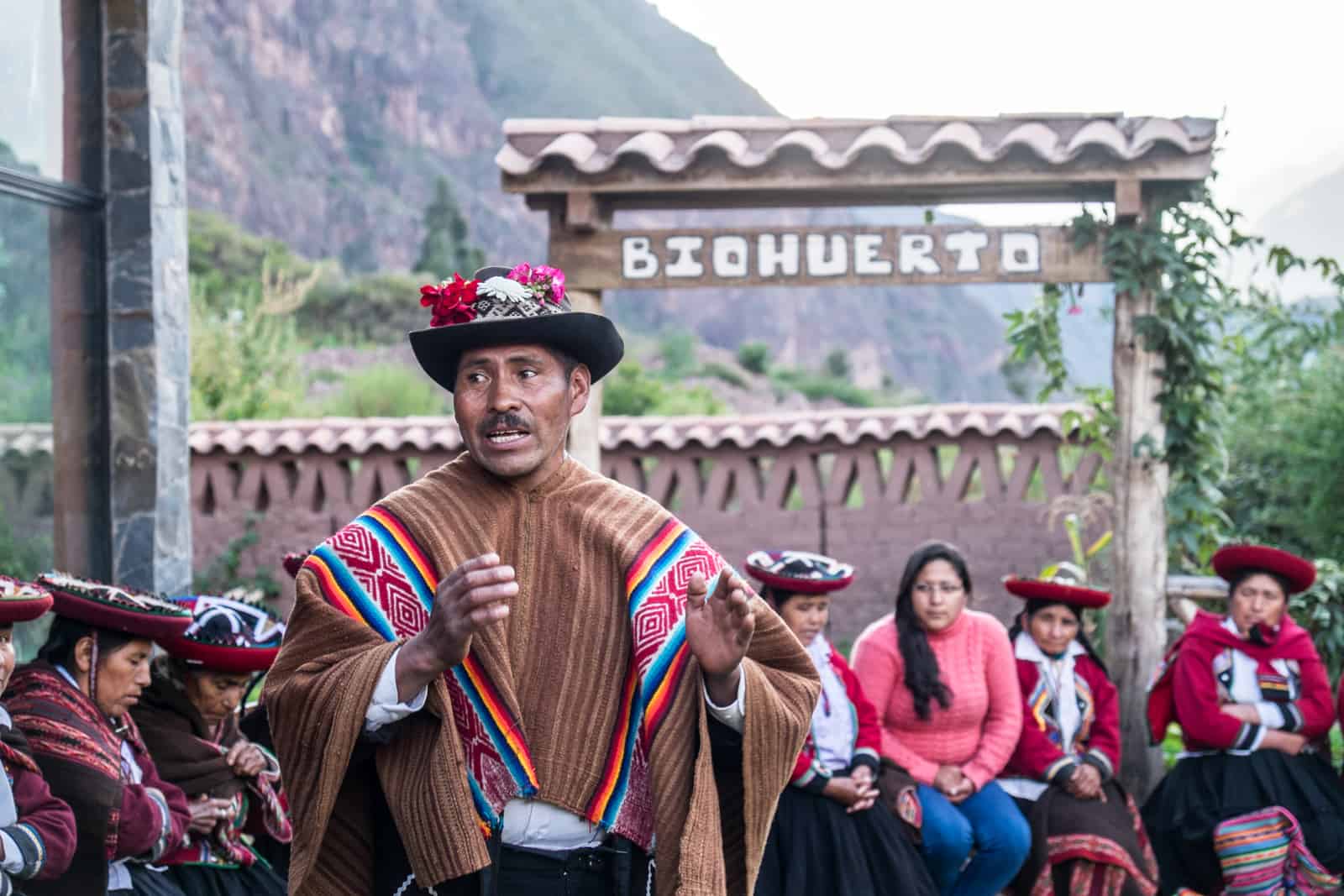
Meeting the indigenous Parwa Community in the Sacred Valley, Peru.
Parque de la Papa
Parque de la Papa (Potato Farm) is a conservation project dedicated to potato seeds. Over 6,000 indigenous community members work together to preserve the 3,000 species of potato in this area. This provides not only economic opportunities and the preservation of indigenous culture but also preserves agricultural biodiversity unique to this region of Peru.
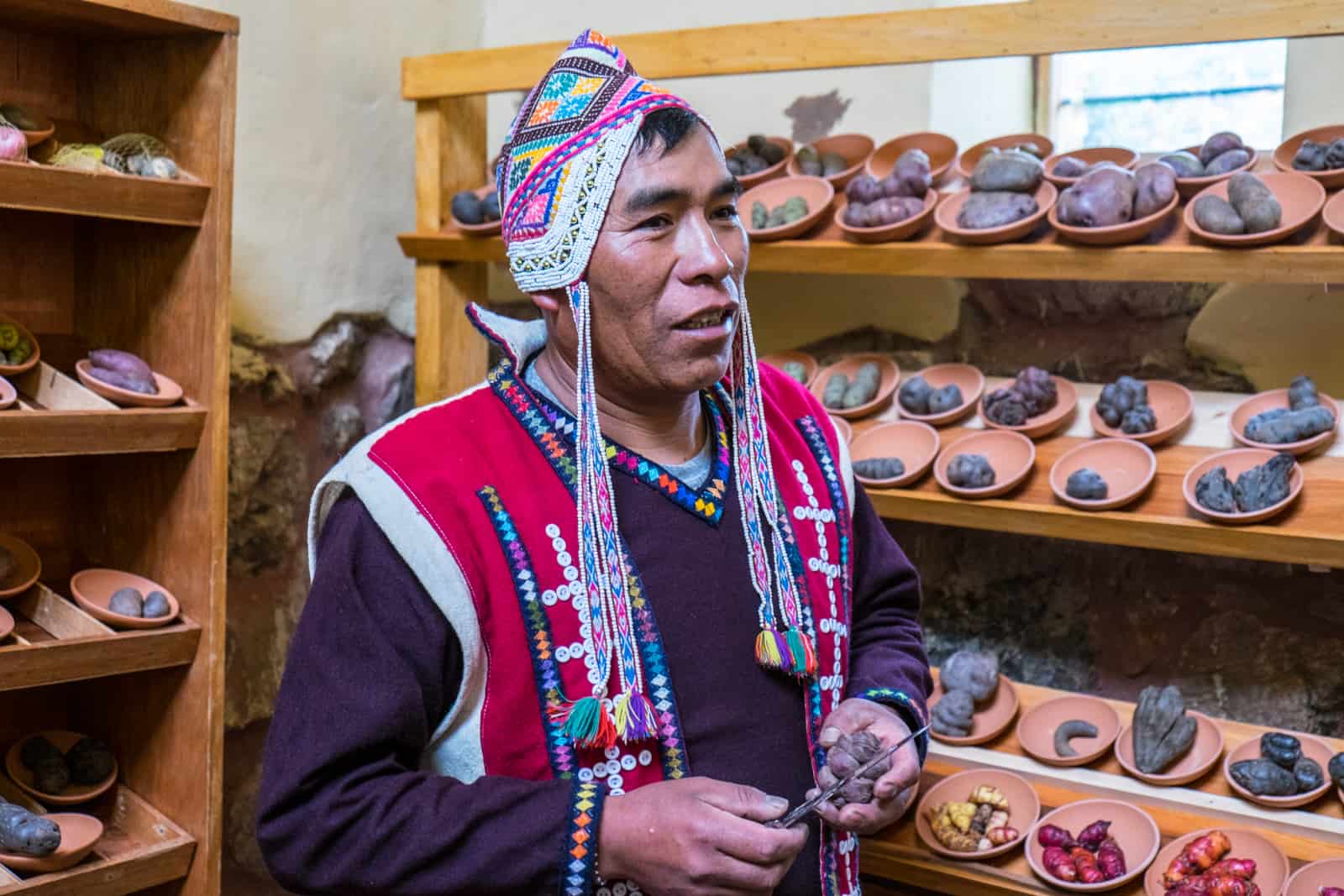
Learning about the 3,000 varieties of potato in Peru at the Parque de la Papa conservation project.
Nunay Reimy restaurant in Cusco
A former G Adventure Chief Experience Officer (CEO) set up Nunay Reimy restaurant in Cusco. Travellers on G Adventures trips visit this restaurant, where a portion of the establishment’s profits is returned to the community.
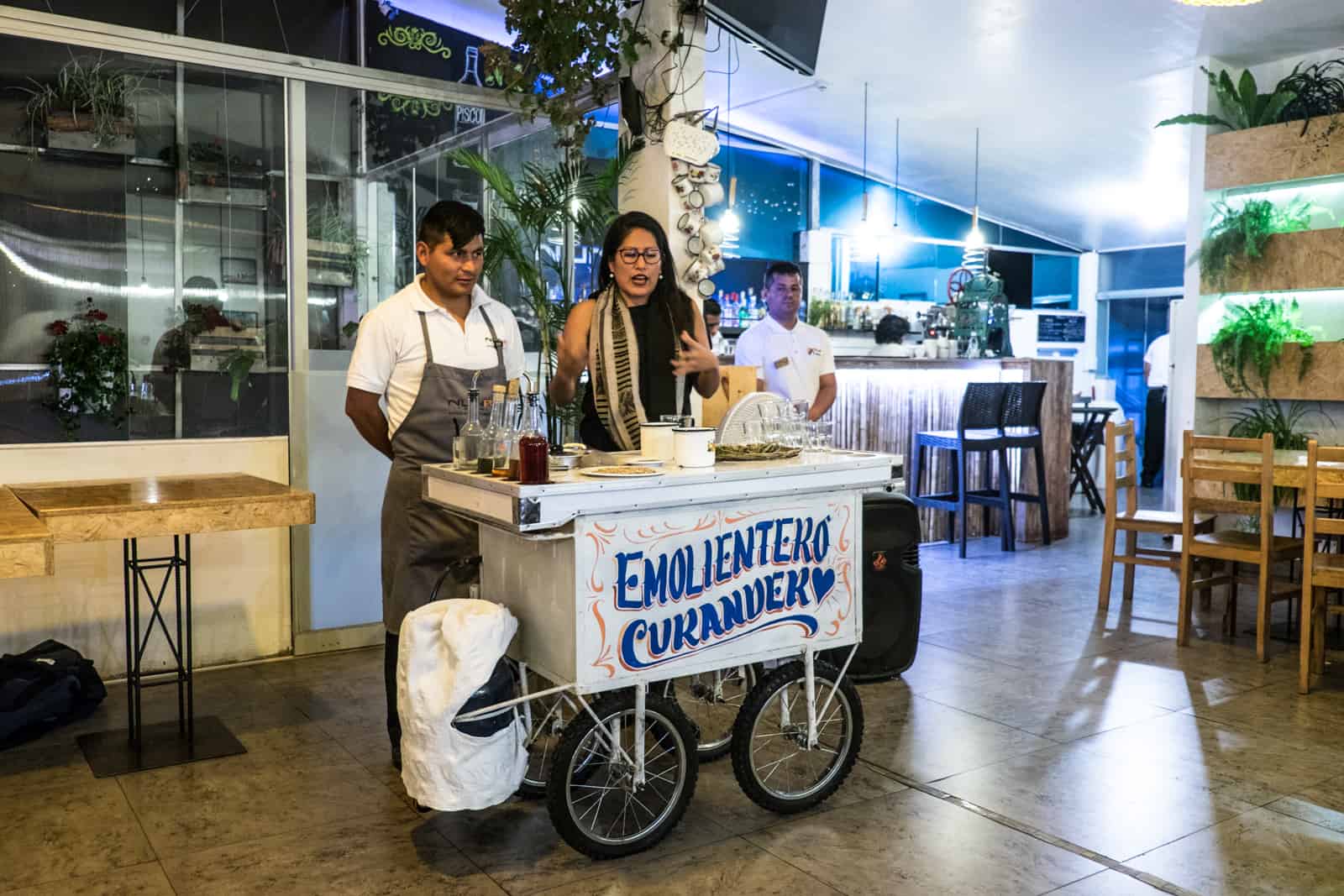
Cuisine insights at Nunay Reimy restaurant in Cusco.
The Inti Runakunaq Wasin youth drop-in centre in Cusco
One of the first big Planeterra projects for G Adventures, money to build the centre was raised by a huge five-year-long international fundraiser by G travellers. Children who live in extreme poverty in Cusco are usually forced to drop out of school and beg on the street to help their families.
You will be contributing to a project that provides children from poor families with a place to get guidance and support. You can support the centre in your visit by buying handicrafts produced by the children who have the opportunity to train in various workshops such as leatherworking and jewellery-making.
Positive Social Impact Projects in Lima
Bite Peru was the first project to come out of the ‘G Values Fund’ where former CEOs looking to move on from their role are given the opportunity to submit a business plan for an idea they can set up at home, with the best and most socially viable being granted the funds for it to start.
What was initially set up to provide culinary journeys in Lima and its thriving food scene soon turned into other offerings which help change the perception of the city. It was with these guys that I visited the San Juan barrio, as well as the street art project emerging in the socially displaced neighbourhood of Callao. I can also recommend ceviche making classes and market tours with a special focus on fruit tasting.
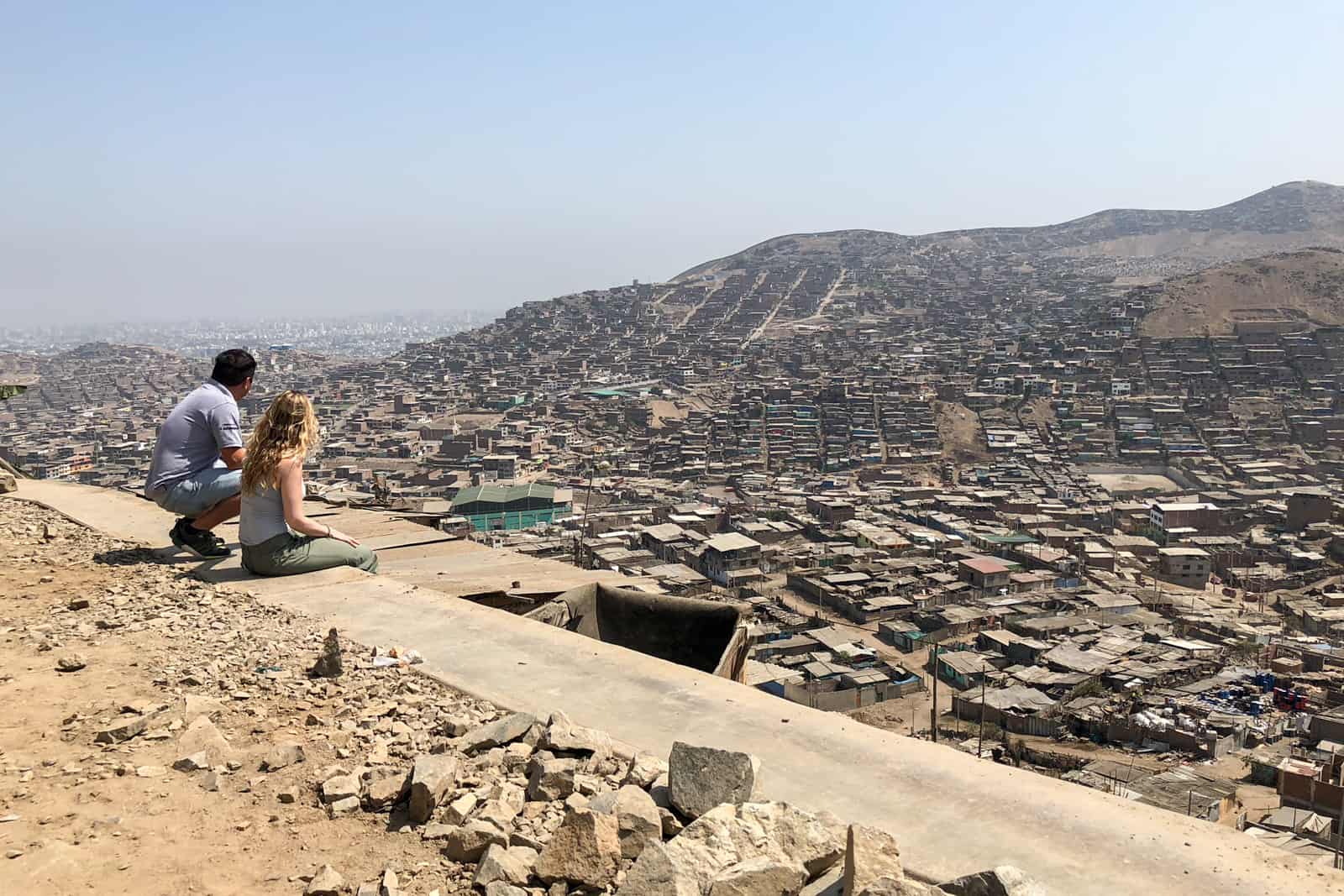
A perception changing tour of the San Juan de Miraflores barrio in Lima, Peru.
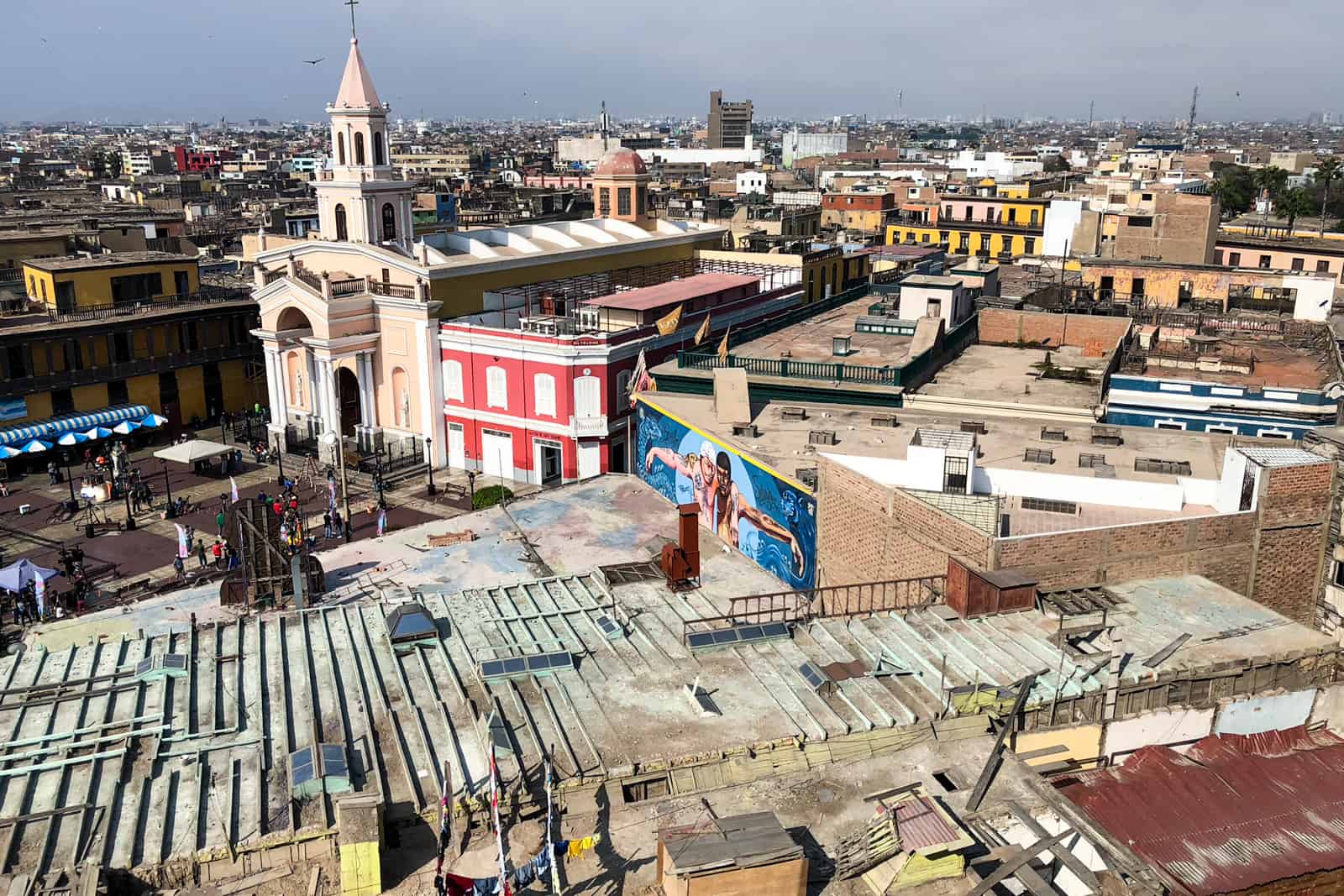
Art is transforming the run-down, dangerous and forgotten neighbourhood of Callao in Lima.
Money in Peru
Using the Peruvian Soles
The currency in Peru is the Sol. It doesn’t take long to get used to it. There are just over three Soles to the US Dollar (USD), around three and a half Soles to a Euro (EUR) and just over four Soles to the Pound (GBP). Rounding up helps you make quick conversions when deliberating prices and making payments.
While some businesses accept US dollars and some ATMs allow you to withdraw it even, it is much easier to pay for day-to-day things with Soles, including food and drink, shopping at local markets and entry to local attractions.
We found that Dollar payments were applied for bigger things and where it was easier to pay by debit or credit card like booking the Rainbow Mountain and Colca Canyon treks and hostel and hotel stays.
I also kept 200 Dollars hidden away in case of emergencies.
ATMs in Peru
There are ATMs in every major city in Peru, typically found near each city’s Plaza de Armas (the main square). It’s highly unlikely that you will find any ATMs in more rural areas, including villages and small towns.
Like most ATMs in South America, it is wise to use those inside a bank or to avoid using any located on the street at night. I always withdrew money in the middle of the day when plenty of people were around.
I was able to use my Mastercard and Visa debit cards. Despite having a pre-loaded travel card that limits being charged extra ATM fees, I was charged a small fee at every ATM transaction in Peru, no matter what card I used.
The fee for withdrawing money at the Peru ATM was always around $5-$7 per transaction, so I soon learnt to take out hearty amounts each time to cover me for a while. The maximum withdrawal was around $200 – $250 per transaction.
How much does it Cost to Travel in Peru?
Peru is significantly cheaper than the other countries in South America, which adds to its popularity. Like anywhere, your daily budget depends on your style of travel and whether you want to live like a local or live it up in comfort.
The biggest cost for a traveller in Peru is normally a trek, connected to visiting Machu Picchu. My other biggest costs were accommodation, since I always took a private room (average prices for a dorm room in Peru are also listed), alongside more convenient means of transport such as a flexible bus pass and an internal flight.
Costs of Travel in Peru (Average Prices in US Dollars)
Cost of Transport in Peru
- Local, long-distance bus rides: $5-$15
- Intercity El Metropolitano bus in Lima: Under $1 (S/. 2.50)
- Peru Hop ticket: $159 for a ‘Get Quick’ pass / $199 for a ‘Full South’ Pass
- An internal flight between Lima and Cusco: $60-$70
- A taxi between Lima airport and a hostel: $20
- A taxi between Cusco airport and a hostel: $5
Cost of Treks in Peru
- Big Treks like Inca Trail or Salkantay – $600 – $1,000+
- Small two-day treks like Colca Canyon – $50
- Day treks from Cusco like Rainbow Mountain – $50 – $100
Cost of Accommodation in Peru
- Dorm in a hostel – $10-$15
- Private room in a hostel – $25
- Room in a mid-range hotel – $35-$50
Cost of Trips and Tours in Peru
- Two-hour speedboat tour from Paracas to Ballestas Islands: $15
- Two-hour sand buggy tour in Huacachina: $15
- Nazca Lines flight: $80 + 30 Soles ($9) airport tax
- Day trip to Colca Canyon: $25-$30 + 70 Soles ($20) tourist entry ticket fee
- Half-day tour to Lake Titicaca, Puno: $10-$15
- Full-day tour to Lake Titicaca, Puno: $20-$25
Cost of Food and Drink in Peru
- Food in a local restaurant (two courses) –$2-$5
- Food in a gringo restaurant – $10-$20
- Food at a local market – $1- $2
- Coffee: $2-$4
- Local beer: $2
Is Peru Safe to Travel to?
While I have never encountered any major problems in Peru, like anywhere in South America, you need to exercise more caution following the region’s turbulent history, which has largely dissipated and hasn’t affected major tourist areas for over a decade. However, it is good to be aware of petty crimes and scams that can still occur and to keep up to date with any Peru travel alerts from your home country.
Safety Tips for Peru and Scams to Avoid
‘Express Kidnappings’ – This is where travellers are taken to an ATM and forced to withdraw money, normally as much as they can get and effectively held against their will until they can extract the money. This is said to be a common occurrence, particularly at Lima airport.
Muggings – This form of petty crime in Peru usually occurs in more dark and isolated areas. There have been some cases at major monuments such as Sacsayhuaman in Cusco, the hilltop monument in Arequipa at sunrise and sunset when the crowds disperse. I also never walked alone in Lima at night, even in Miraflores, away from the busy areas like Parque Kennedy.
Something-On-Your-Shoe Distraction – There have been a few stories of someone spilling something on your shoe or dropping money in front of you where you feel inclined to help and pick it up. Distraction is the greatest tool for those wanting to commit petty crimes. Don’t fall for it.
Short-changing – I encountered this on many occasions in both shops and hostels. Always, always check your change. I’ve had everything from being given four 10-cent coins when my change should have been four Sole coins to a hostel receptionist giving me change in coins and conveniently leaving out the 10 Soles note that should have come with it. Refuse to leave until you get your right change. I never gave in.
Always carry a photocopy of your passport and not the real thing! I used a Pacsafe Portable Safe the entire time I was in Peru and locked it to the bathroom sink pipes and/or furniture attached to the wall. I also had photocopies of my travel insurance, vaccinations and relevant trip documents.
Only carry enough cash that you need for the day. I only took my credit or debit cards when I knew I had to withdraw cash. I didn’t carry them around daily and kept them stored with my passport in the safe mentioned above.
Keep your bag with you and in sight at all times. I always had my daypack/handbag slung over my shoulder or on my lap, especially in crowded places.
Avoid travelling at night in Peru. Travelling by night is still not considered the best option, as armed holdups on buses and other transport routes still occur, more so in the far northern reaches of the country and on the Peru-Bolivia border at Lake Titicaca. I only travelled overnight on the Peru Hop tourist bus.
Be aware of what border crossings are accessible or not. For example, many official websites mention that the border to Colombia is best avoided due to narcotics (drug) trafficking.
Don’t withdraw money from ATMs at night, and don’t withdraw money from an ATM in an unpopulated or dodgy-feeling area. Withdraw enough money from an ATM in the centre of major cities so that you have enough with you to last through less busy and remote areas.
Don’t flash your valuables. This might sound obvious, but the number of travellers I saw with a camera hanging off their neck or dripping in expensive jewellery and clothing was abundant. Don’t be an obvious target when you already look ‘gringo’ enough. And especially hide your stuff in less affluent and less touristic areas.
Use Uber, especially at night. As a solo female traveller in Peru, there were times I met friends in town for drinks but didn’t want to walk back through quiet, narrow streets at night, especially in Cusco. Uber was a great choice, and I never had any issues. My Peruvian friends always recommended it.
Hold onto your bag when riding local buses, and don’t put it in the overhead compartment. There are countless stories of theft on buses, as well as a classic tale of someone telling you that you have to move seats when you don’t (this is a strategic move to be able to rob you more easily).
Is Lima Safe?
The smaller cities in Peru, as in South America generally, are no more of a major threat than other large cities worldwide. However, the Capitals have a lot of major no-go areas. Therefore in Lima, you absolutely need to know where you can and can’t go and what areas are absolutely and completely off-limits.
It’s wise to do some digging on Lima before you arrive. A handful of neighbourhoods in Lima, in particular, should be avoided – like the Callao district next to the airport and Rimac just across the bridge from Downtown Lima and the Presidential Palace.
Miraflores is the safest neighbourhood in Lima and where you should, ideally, stay. It is the more affluent one where locals can afford security guards at both their homes and to sit guard outside of their business premised all night. Miraflores is, therefore, fine to roam by day, yet I would still exercise caution at night when the residential streets are quiet and there is not a security guard on every corner like those roaming at Parque Kennedy.
Barranco, the more artsy and bohemian neighbourhood south of Miraflores, is also a good choice to either visit or stay when in Lima.
When a new district turns into another, it is not marked, and it is easy for your curiosity to get the better of you. A friend and I accidentally wandered into the neighbourhood of Rimac during our day exploring Lima Downtown. If it wasn’t for a local woman on a balcony furiously waving for us to get the hell out, who knows what might have happened? A Peruvian friend later told me we would have 100% been robbed if we were just one more block east.
Impoverished neighbourhoods back onto the affluent ones like Miraflores, and the city widely sprawls to include some VERY dangerous places. For example, next to the Mercado on the fringes of Miraflores is the neighbourhood of Surquillo. Wander too far in, and you may stand out too much. One traveller’s curiosity saw him robbed and beaten, as was his wife, who was wearing a camera around her neck.
Lima is not the place to show your riches. You can feel the atmosphere drop to another level. Don’t take the risk if you haven’t done your research.
On the other hand, Lima is developing with social enterprise schemes and local tours booming. These are helping the areas to regenerate and educating visitors about Peruvian politics, society, culture and what is happening today. I visited an art project in Callao and the San Juan favela/barrio in the east, guided by locals and with genuine insight into how things work and the changes taking place that could turn things around for those less prosperous here.
Lima is so complex, and it is all too easy to dismiss by spending two days in Miraflores before leaving altogether.
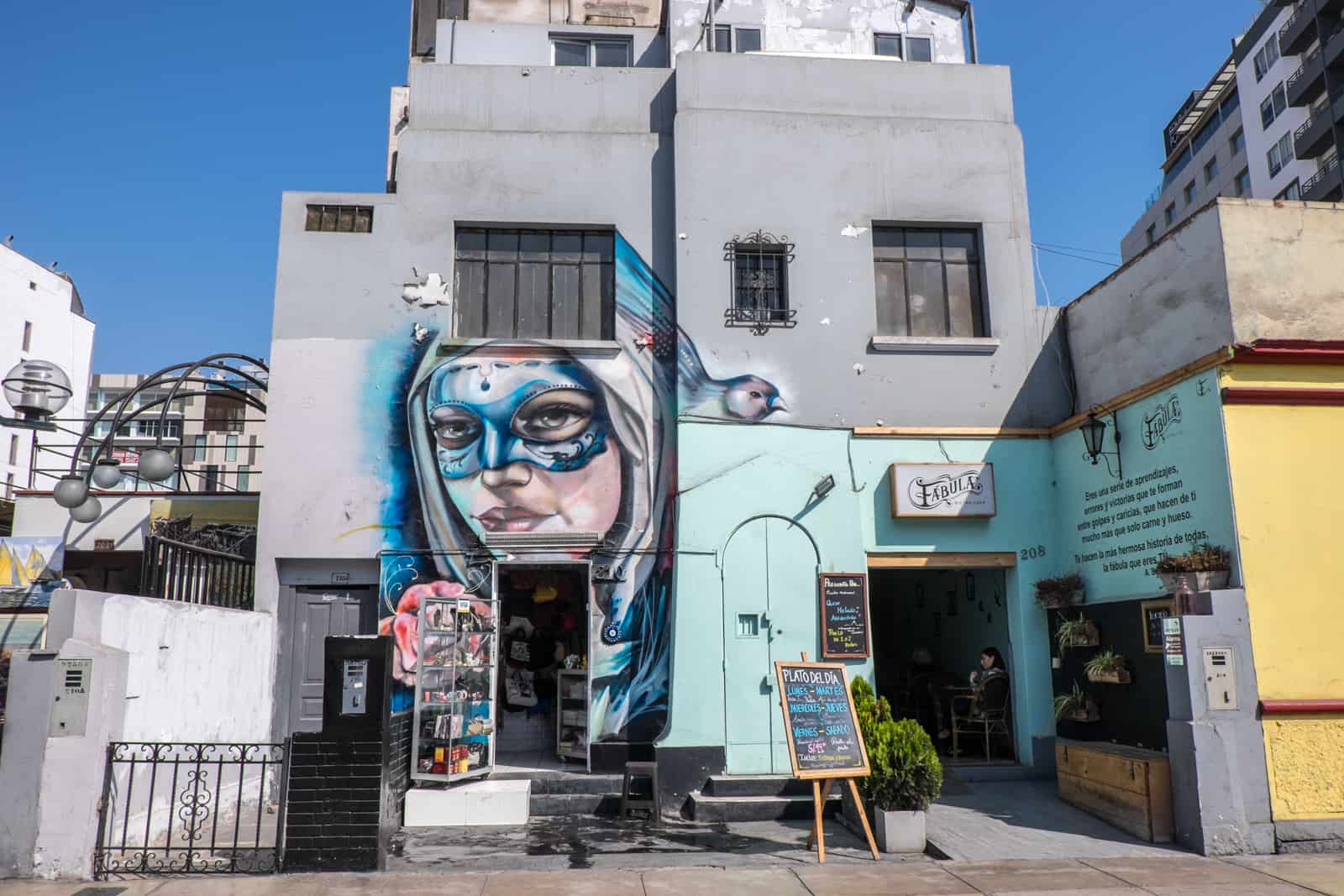
The Miraflores neighbourhood of Lima.
The Best Food in Peru
Ceviche is Peru’s classic dish, and Lima is the heart of the dish’s origination. A melody of fresh fish, lime juice and the rich flavours of pepper, onion and chilli combined, it has to be tried at least once as a rite of passage to Peru. You’ll find everyone from local markets to high-end restaurants serving it with their own little twist.
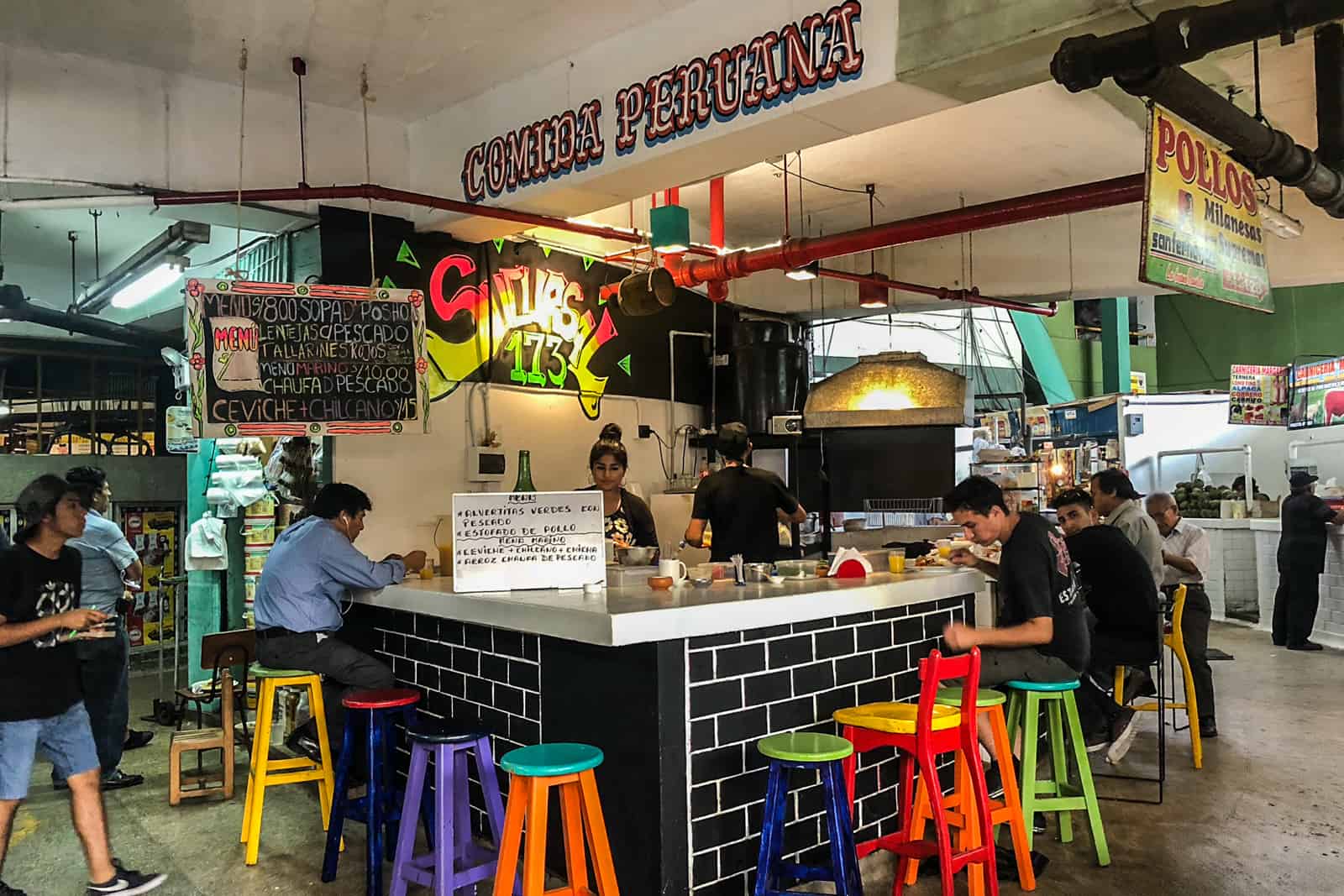
A Ceviche stall in a market in Lima, Peru.
Lomas Saltado is ‘salted beef’; marinated strips of beef are combined with a stir fry type mix of pepper, onion and tomato and served with rice. It’s often also served with fries or a mix of both.
Aji de Gallina is well worth a try, especially since it’s always on the menu when you eat in a local establishment. It’s a yellow cream sauce made from yellow Aji peppers, usually served with meat such as chicken, hard-boiled eggs, potatoes and rice. The best ones normally have a light spicy flavour for an extra kick.
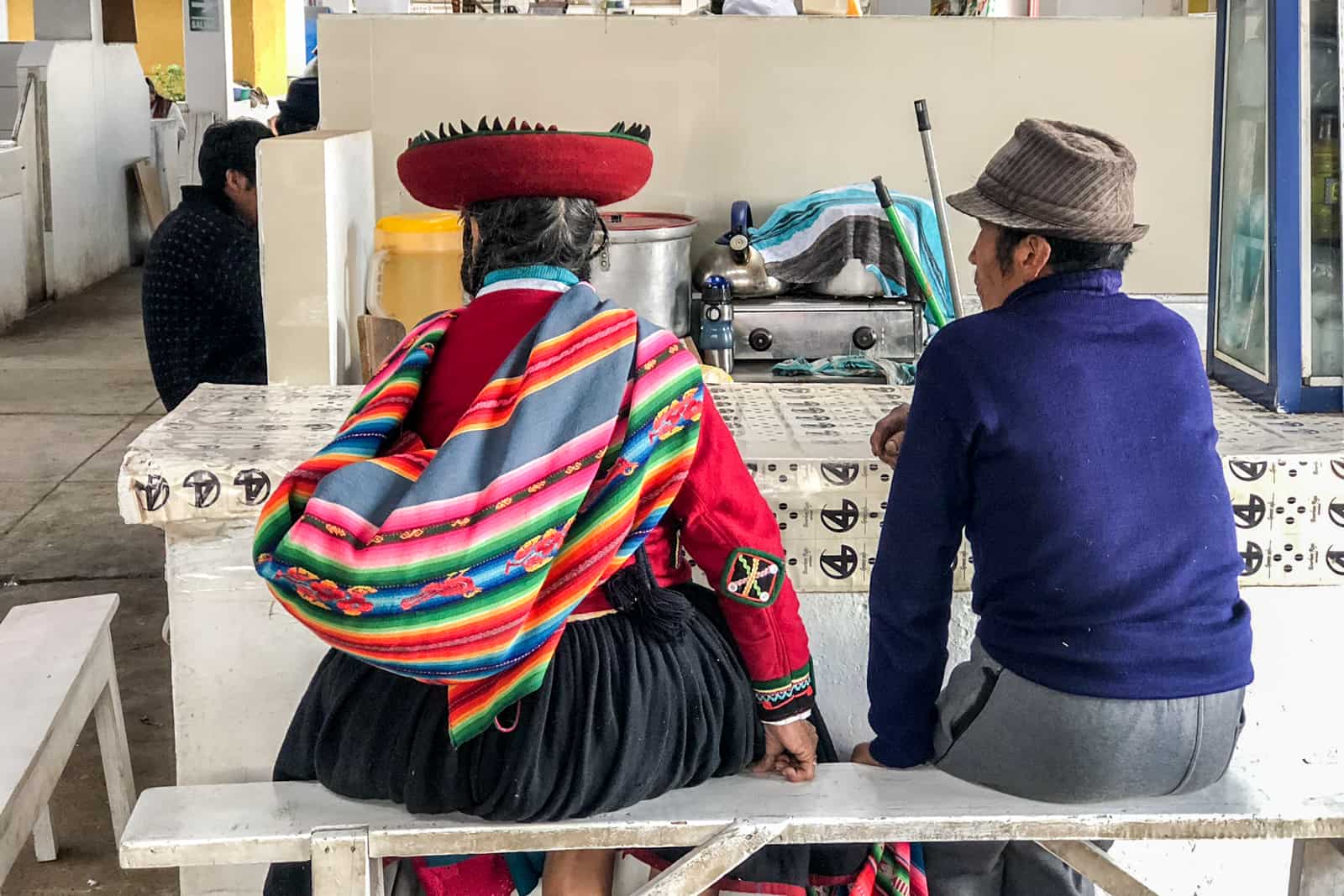
Locals dining at the San Blas market in Cusco.
Pisco Sour. Ok, this is not food, but it’s technically a staple part of the culinary menu. Lemon juice, egg white and Peru’s Pisco (a fermented wine) on ice, topped with bitters, make up this famous and timeless classic cocktail. Of course, in Peru, it’s cheaper and made to perfection.
Internet in Peru
The Internet in Peru can be patchy and not always fast or reliable, which makes travel in Peru and planning a little frustrating. Get yourself a local SIM card, which saves you from relying on the patchy hostel and guesthouse Wi-Fi. A SIM card in Peru costs about 15 Soles (about $5 USD), and I got a starter package with a local carrier, Claro, for 30 Soles (about $5 USD), which gave me 3MB of data.
Remember to take a copy of your passport to purchase the SIM. The main two carriers are Claro and Movistar, and you will find many convenience stores, supermarkets and other outlets where you can top up. Just look for the flag signs and shop window stickers for Claro and Movistar.
Drugs in Peru
Peru is the largest exporter of cocaine to the western world, with this trading belt up into Colombia enticing ‘Narco Tourism’. While offers of cocaine and cannabis frequently occur on the street, especially in Cusco, don’t be that tourist whose curiosity gets the better of them.
Punishment for drugs in Peru is severe, especially if you try to take drugs out of the country (Google ‘Peru Two’ for an example).
Travel to Peru adventurously, safely, and responsibly. Is there anything else you would add to this list?
Planning a Peru Trip? – Pin It!
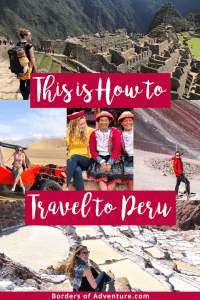
The post This Is How to Travel to Peru – All You Need to Know Guide appeared first on Borders Of Adventure.







